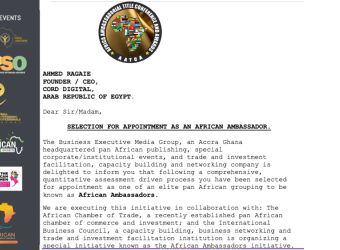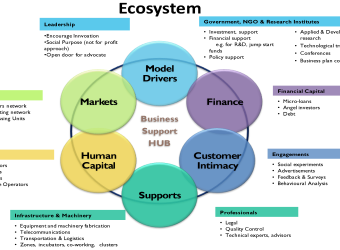Blogs
- Home
- Blogs

Consumer Psychology: How Do Advertisements Influence Purchasing Decisions?
Advertising plays a pivotal role in guiding purchasing decisions by leveraging psychological principles to persuade consumers to choose specific products over others. By studying consumer psychology, companies can design more impactful advertisements that boost sales and strengthen brand loyalty. But how exactly do advertisements influence buying choices?
1. Emotional Impact and Sensory Stimulation
Many advertisements rely on evoking emotions such as happiness, nostalgia, or even fear to capture consumer attention. For example, car commercials often feature scenes of adventure and freedom to spark desire, while luxury brands emphasize exclusivity and sophistication. When consumers emotionally connect with an ad, they become more likely to make a purchase.
2. Social Influence and Credibility
Social influence is one of the most powerful psychological factors affecting consumers. Many people rely on celebrity endorsements or peer reviews when making buying decisions. Companies capitalize on this phenomenon by collaborating with social media influencers or showcasing customer testimonials in their ads to build trust in their products.
3. The Scarcity Principle and Exclusive Offers
Many ad campaigns use the principle of scarcity, such as limited-time offers or special-edition products. This tactic encourages consumers to act quickly out of fear of missing out (FOMO). Phrases like “Offer ends soon!” or “Limited stock!” create a sense of urgency that drives faster purchasing decisions.
4. The Role of Colors and Visual Design
Colors and design play a crucial role in grabbing attention and shaping consumer emotions. For instance:
- Red symbolizes energy and excitement, often used in food ads to stimulate appetite.
- Blue conveys trust and stability, making it popular in banking and tech advertisements.
Strategic visual elements can significantly influence how consumers perceive a brand.
5. Targeted Advertising and Artificial Intelligence
With technological advancements, ads have become more personalized thanks to AI and data analytics. Companies collect consumer data on interests and online behaviors, allowing them to deliver highly targeted ads that increase conversion rates.
Conclusion
Advertisements profoundly influence purchasing decisions by triggering emotions, leveraging social proof, using scarcity tactics, and employing captivating designs. Thanks to technological progress, businesses now have an even deeper understanding of consumer psychology, enabling them to craft highly effective marketing campaigns that drive sales and foster long-term customer loyalty.
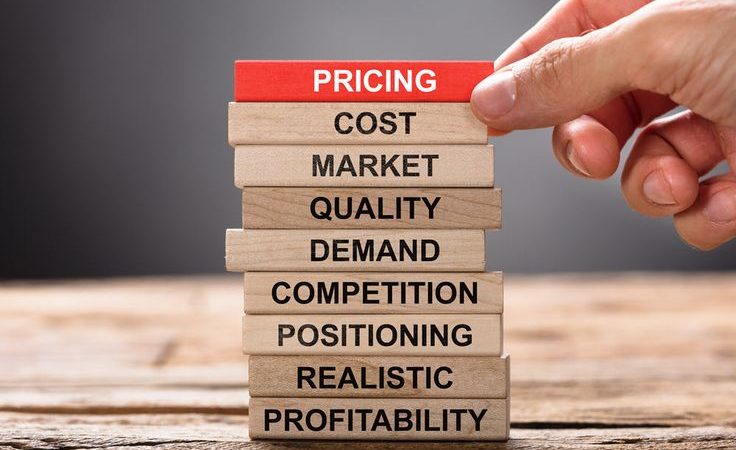
Complementary Pricing: How to Boost Profits from Secondary Products?
In the business world, profits don’t solely rely on selling core products – revenue can be significantly enhanced through secondary or complementary products that support the main offering. This strategy, known as Complementary Pricing, involves offering additional products or services that complete the customer experience, increasing the overall purchase value and strengthening customer loyalty.
1. What is Complementary Pricing?
Complementary pricing refers to pricing products that depend on a main product – items that can’t be effectively used without the core product. This approach is commonly used in industries requiring continuous supplies or accessories to maximize the primary product’s utility.
2. Complementary Pricing Strategies to Increase Profits
- The “Razor and Blades” Model
This strategy involves selling the main product at a low price while generating profits from complementary accessories.
Example: Printers are sold at low prices, while companies make profits from expensive ink cartridges. - Bundle Pricing
Offering packages that combine the core product with complementary items at an attractive total price.
Example: Software companies providing licenses for multiple programs in a single bundle, increasing purchase value. - Differential Pricing for Byproducts
Selling secondary products resulting from manufacturing the main product to generate additional profits.
Example: Food companies selling byproducts like vegetable oils or grain residues as animal feed. - Subscriptions and Consumable Products
Implementing a subscription model for products requiring regular replenishment.
Example: Razor companies offering monthly subscription services to deliver new blades to customers.
3. Benefits of Complementary Pricing
- Revenue Growth: Instead of relying on single product sales, continuous revenue streams can be created from secondary and complementary products.
- Enhanced Customer Loyalty: When customers find added value in complementary products, they become more attached to the brand.
- Increased Repeat Purchases: Complementary products provide additional reasons for customers to return and make more purchases.
4. Challenges and Solutions
- Customer resistance to expensive accessories → Solution: Offer attractive pricing bundles.
- Risk of customers buying cheaper alternatives → Solution: Provide exclusive features in complementary products to maintain loyalty.
Conclusion
Complementary pricing is a smart strategy to maximize profits by offering additional products that support the core offering. Through bundle pricing, subscriptions, and differential pricing for byproducts, companies can achieve financial sustainability while increasing the value delivered to customers. This approach not only boosts revenue but also strengthens long term customer relationships.

Business Management: Keys to Success in the Modern Corporate World
Business management is the backbone of any successful company or organization. In the face of intense competition and globalization, the need for strong strategies has become essential to ensure sustainability and market excellence. In this article, we will explore the most important keys to successful business management and how to apply them effectively.
1. Establishing a Clear Vision and Strategic Goals
A clear vision is the cornerstone of any successful company. Strategic goals must align with market needs and customer requirements, guiding the company toward sustainable success.
Tips to Improve Vision and Strategy:
- Set SMART (Specific, Measurable, Achievable, Relevant, Time-bound) goals.
- Monitor progress regularly and adjust goals as needed.
- Share the vision with the team to ensure alignment and collaboration.
2. Effective Leadership and Its Impact on Success
Successful leaders are key to business success. They don’t just make decisions—they inspire teams and foster a culture of innovation and growth.
Traits of a Successful Leader:
- Ability to make sound decisions during critical times.
- Effective communication and building strong relationships with the team.
- Adaptability and quick response to challenges.
3. The Importance of Human Resources and Employee Development
Employees are the most valuable human capital in any organization. Investing in them enhances productivity and fosters a positive work environment.
Strategies to Enhance HR Performance:
- Provide ongoing training programs.
- Offer incentives and rewards to motivate performance.
- Promote a supportive and innovative workplace culture.
4. The Role of Innovation and Technology in Achieving Excellence
With rapid technological advancements, digital transformation and innovation have become essential elements of success.
How to Apply Innovation in Business:
- Use analytics and big data to make better decisions.
- Adopt smart management systems to improve operational efficiency.
- Develop products and services that meet evolving market needs.
5. Wise Financial Management for Sustainability
Sound financial planning enables companies to achieve stability and sustainable growth.
Tips for Successful Financial Management:
- Create a clear budget and monitor expenditures.
- Minimize financial risks through income diversification.
- Invest wisely in promising opportunities.
6. Digital Marketing and Strategies for Reaching Customers
In the digital age, online marketing has become one of the most powerful tools for increasing sales and building brand identity.
Effective Marketing Strategies:
- Optimize for search engines (SEO) to boost visibility on Google.
- Use social media to reach target audiences.
- Provide valuable content to attract customers and build trust.
7. Building Strong Customer Relationships to Foster Loyalty
Delivering excellent customer service helps earn trust and ensures long-term loyalty.
How to Improve Customer Experience:
- Listen to customer feedback and improve services accordingly.
- Provide fast and responsive support across all channels.
- Create a smooth and user-friendly experience.
8. Risk Management and Informed Decision-Making
Proactive risk planning helps companies handle challenges effectively.
Ways to Manage Risk Effectively:
- Analyze data and forecasts to make well-informed decisions.
- Develop contingency plans to address potential crises.
- Train teams on how to act in difficult situations.
Conclusion
Achieving success in business management requires a combination of factors, including strong leadership, strategic planning, innovation, and managing customer relationships. By effectively applying these key principles, any company can thrive in today’s competitive market.

Best Practices for Increasing Productivity and Reducing Costs
In today’s competitive business environment, companies aim to maximize efficiency by increasing productivity and reducing operational costs. To achieve this, organizations must adopt effective strategies that enhance performance without compromising the quality of products or services. Below are some of the best practices that help achieve this balance.
1. Optimizing Time and Resource Management
Effective time management plays a major role in boosting productivity. This can be achieved through techniques such as organized work schedules, task prioritization, and minimizing waste from unnecessary activities. Additionally, investing in technological tools like Enterprise Resource Planning (ERP) systems helps optimize resource utilization and lower operational costs.
2. Automating Processes and Embracing Modern Technology
Digital transformation and process automation improve efficiency and reduce human error. Companies can utilize project management systems, accounting software, and artificial intelligence technologies to streamline operations and increase production speed. This reduces the need for costly human resources and enhances overall productivity.
3. Improving Employee Performance and Training
Developing employee skills directly contributes to increased productivity. This can be achieved through regular training programs, performance-based incentives, and creating a supportive work environment. Encouraging collaboration and teamwork also enhances operational efficiency and reduces costly errors.
4. Reducing Waste and Improving Cost Management
Cost analysis and identifying areas for improvement help reduce unnecessary expenses. This can be achieved by renegotiating supplier contracts, using raw materials efficiently, and reducing energy consumption. Adopting lean manufacturing principles further helps eliminate waste and boost productivity.
5. Leveraging Analytics and Data in Decision-Making
Relying on data and analytics helps identify weaknesses and improve performance. Businesses can use data analysis tools to understand customer behavior, evaluate process efficiency, and make informed decisions that lead to greater efficiency and reduced operating costs.
Conclusion
Achieving a balance between increased productivity and reduced costs requires effective strategies that include time management, technology adoption, employee motivation, and cost optimization. By implementing these practices, companies can ensure sustainable growth and strengthen their competitiveness in the market.

Artificial Intelligence in Finance: How It’s Reshaping Markets and Institutions
The financial sector is undergoing a radical transformation thanks to artificial intelligence (AI). Banks, investment firms, and financial markets are increasingly relying on AI technologies to enhance efficiency, reduce risks, and improve customer experiences. From real-time data analysis to automated trading, AI is reshaping the financial landscape in unprecedented ways.
1. AI’s Impact on Financial Markets
- Algorithmic Trading & Market Prediction
AI has become a fundamental tool in financial trading. Investment firms now use machine learning algorithms to analyze vast amounts of data and execute trades faster and more accurately than humans. These systems can detect hidden patterns in market behavior and predict price trends, improving trading efficiency and reducing unexpected volatility. - Risk Assessment & Portfolio Management
AI enhances risk analysis by evaluating financial and historical data, helping institutions identify potential risks and make more informed investment decisions. AI-powered models also classify clients based on risk profiles, enabling safer lending and investment strategies.
2. AI’s Role in Financial Institutions
- Enhancing Customer Experience
Banks and financial institutions leverage AI-powered chatbots and virtual assistants to provide faster, more personalized services. These tools handle customer inquiries, process transactions, and offer tailored financial advice—boosting customer satisfaction while reducing reliance on human staff. - Fraud Detection & Financial Crime Prevention
AI analyzes transaction data to detect unusual patterns that may indicate fraud. Machine learning systems continuously improve, identifying potential threats and alerting institutions to take preventive measures, thereby strengthening financial security.
3. Challenges & Future Considerations
Despite its benefits, AI in finance faces challenges, including the need for clear regulations to ensure transparency and security, as well as concerns over job displacement due to automation. As technology evolves, striking a balance between innovation and consumer protection will be crucial for sustainable adoption.
Conclusion
AI is revolutionizing finance by boosting efficiency, mitigating risks, and improving customer interactions. As adoption grows, institutions must develop balanced strategies that embrace innovation while ensuring security and ethical responsibility—paving the way for a smarter, safer financial future.

SAMSUNG In Vietnam In Stade of China , Ahmed Ragaie
This research released by Ahmed Ragaie in 2014 during his masters degree from ESE, University of Buckingham.
In this assignment I chose Samsung as a MNC and Vietnam as a HC also I’ll focus more on Samsung Electronics, the reasons for choose SAMSUNG as MNC and Vietnam as HC will be discussed in the following chapters
As I said I’ll focus more on SAMSUNG ELECTRONICS
SAMSUNG Electronics is a south Korean MNC, its head quarters lies on “Suwon, South Korea”, it is the flagship subsidiary of SAMSUNG Group that’s because its represent 70% of the groups revenues and this measured in 2012, SAMSUNG electronics has assembly plants and sales networks in 80 countries all over the world
Recently the company has diversified into consumer Electronics, it’s considered as the world’s largest manufacturer of Mobile & smart phones and the most popular smart phone for the company is SAMSUNG Galaxy. Also the company considered as a major vendor of Tablet computers (SAMSUNG Galaxy Tab) also the company produce many other Electronics devices that I will show in the next chapter “ introduction – SAMSUNG back ground ”
At the end of the third quarter of 2010, the company had surpassed the 70 million-unit marks in shipped phones that giving it a global market place of 22 % that was more than Nokia by 12 %
SAMSUNG Electronics sold 280 million Mobile phones in 2010 that represent a market share of 20.2 %.
The most sales revenues came from the smart phone “SAMSUNG Galaxy” also the company exceed apple in a global sales of the smartphones during the third quarter 2011, the total market share was 23.8 % in comparison with Apple that had 14.6 % market share.
The company became the world’s largest cellphone market in 2012, which sold 95 million smart phones in the first quarter
- Introduction & Background to MNC and HC
SAMSUNG Background
Samsung was founded on 1938 as a trading co. over the next 3 decades from the company existence, Samsung has diversified into groups or areas that’s include insurance, textiles, food processing, securities and retail. During 1960s Samsung expand its overseas trade and on the last 1960s Samsung entered the electronics industry. 1970 considered as a crucial period in shaping present day Samsung.
The following are some statistics on Samsung
Samsung industrial subsidiaries include Samsung electronics and this considered as a world’s largest information technology company according to the measurement of 2012 revenues, and also considered No. 4 in market value. Samsung heavy industries considered as 2nd largest ship builder and this measured by 2010 revenues, and also Samsung engineering and
Samsung C& T considered no. 13th and 36th largest construction companies.
Also SAMSUNG Include other companies in other fields but the main important in this assignment is SAMSAUNG Electronics
Samsung has a very high influence on South Korea’s economic development, politics, media and culture. Samsung represent fifth of total exports of South Korea
Backing to Samsung’s background
In 1990 SAMSUNG has increased its globalized activities and electronics as well in particular the mobile phones and semiconductors has became the most important products that bring income to SAMSUNG
As I mentioned I’ll focus more in Samsung Electronics its one of the world’s leader it produces many kinds of consumer devices like DVD players, Digital & cameras, LCD panels, computers and laptops, printers Semiconductors like flash memory, Ram, etc.…. also communications devices ranging from wireless handsets and smartphones to networking gear also Samsung make a lot of other products
SAMSUNG Electronics began construction on building the world’s largest mobile phone factory in Vietnam at 2013 and this will take a critical discussion in the following chapters
Vietnam Background (characteristics, culture, political systems)
Vietnam located in southeastern Asia bordering the gulf of Thailand, the geography of Vietnam consist of mountains in the Western north and also has densely & hills
Vietnam’s Population count 82,689,518
Religions Buddhist, Hoa hao, cao dai, Christians and Muslims
Language: the official language is tonal official language that can be compared with Cambodia’s language and there are 6 difference tones that can be used
There are other language spoken such as Chines, Khmer, Cham and other languages spoken although there are some similarities to Southeast Asian language
Vietnam is a communist state and it has a mixed economy, Vietnam is a member of the Asian pacific economics cooperation (APEC) and also the association of Southeast Asian nations (ASEAN)
Culture in Vietnam
To get more understanding about Vietnam culture on the figure below
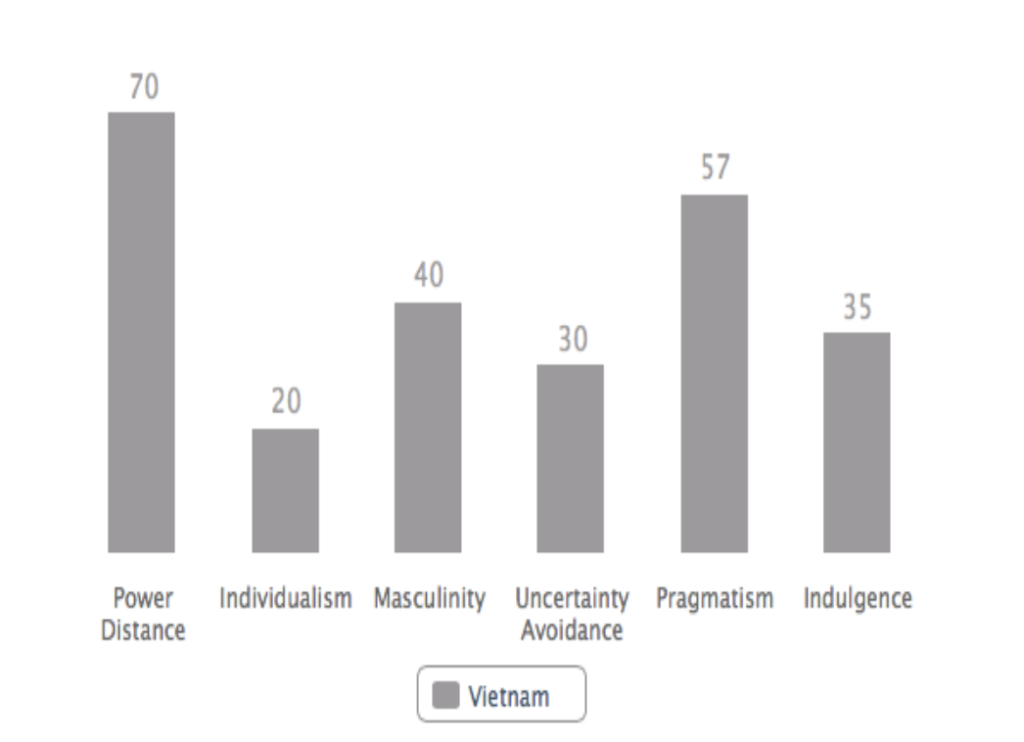
If we investigate and explore the Vietnamese culture among the lens of the 6-D Model, we can get a proper overview of the deep drivers of Vietnamese culture relative to other world cultures
The power distance score is 70 that’s mean people accept hieratical order and This dimension deals with the fact that all the individuals are not equal. The power distance describes that the less powerful people in Vietnam expect and accept that the power is distributed unequally also the people believe that they shouldn’t aim or seeking to get more or higher than their current position in society or business they already work
Individualism Vietnam score is 20 that’s is low and this reflect that Vietnam is collectivistic and in a collectivistic countries the priorities to the groups rather than the individual that’s mean the interests and goals of the group is more important than the personal interests and goals
Masculinity score 40 and this considered a feminine society. And In feminine countries the focus on “working in order to live. Also managers seeking and strive for consensus, people value equality, solidarity and quality in their working lives. But in Vietnam the feminine percentage aren’t so much higher than the masculinity
Uncerinaity avoidance: Vietnam score 30 that’s low and this reflect that citizens of Vietnam don’t care if things are not completely done, this also reflect that members of the culture feel threatened from ambiguous or unknown situation and they have a beliefs that institutions will try to avoid this
Pragmatism: Vietnam score is 57 that’s mean it’s a pragmatic culture, in the pragmatic societies people believe on that the truth depends on situation and time and also they can adopt the traditions on an easy way to change conditions that’s reflect Vietnam’s people is practical persons on a proper degree and don’t try to find reasons for what happened around the
- Main Evaluative Content of the Case Study.
Globalization Theory:
o What is Globalization?
o Drivers and critical aspects of Globalization and International Trade
o Evaluation of benefits and shortcomings of Globalization for MNC in HC

Globalization is the growing interdependence of national Economies that including and involving the Customers Producers Suppliers and government in variety different markets. The global marketing refers to the multinational firm’s trend in selling and distributing products & services in many different countries all over the world. Definitely this trend has increased over the last 3 decades that the fundamental shift has been occurred in the world economy. We have moved away from a world in which national economic system that was relatively self contained entities isolated from each other by barriers for cross border investment & trade by many things like language, distance time zone and the differences in each country in culture, business system and government regulations, but we have moved toward declining those barriers due to advances in transportations and telecommunications technology, and the material culture is starting to look similar the world over and the national economies system have merged into an interdependent/ integrated Global economic system
The most 2 important parts or implications of globalization are the globalization of markets that refers to the merging of historically distinct and separate national markets into the global marketplace and this occurred because of the new laws and decreasing barriers that make the trade and business are more easy to sell and buy globally also refers to that the consumers in different countries are beginning to converge on some global norm so all of the above help many companies not only Samsung to benefit from this also many small and medium sized business. Also globalization in markets helps many countries like Vietnam to gain benefit
The second part or implication is globalization in production that’s means sourcing goods and services from locations around the world to gain advantages like cost and quality so this allow the MNC to decrease its overall cost structure so this refers to the fact that products or parts are made in different countries, since different countries have different advantages that lies on Human resources, Land, energy and others. Through this Samsung can gain benefit from enter new country that has cheap labor cost Like Samsung did with china and after the chines labors cost has increased, the company shifted toward more investment in Vietnam also this gain benefit to Vietnam because it’ll offer new opportunities for new jobs also it’ll make the employee more expertise by learning from Samsung and improve the Vietnam’s economy
There are 2 main drivers of globalization that increase and growing the tendency of globalization and international trade the first one I discussed it in the globalization in markets and production in the previous section and the other one including the following:
The advanced technology and the rapid development in telecommunications plus the improvements and the development that happened in transportation and information processing technologies
Actually after the world war a lot of western countries started to work together and decided to remove the barriers on trade to make free trade markets and also the other countries has followed the western countries and also did that. By time the globalization trend increasing rapidly and many things helps to conduct it like microchips, which resulted in the Internet. Defiantly Samsung and Vietnam gain a lot of benefit from that and this will be very clear in the following paragraphs
Some benefits and shortcomings of globalization on Samsung and Vietnam but separate benefits that’s means not a common benefits from Samsung productions as MNC in Vietnam as a HC
Samsung gained tremendous opportunities from Globalization all over the world and just one of the examples, in 2002 the company constructing the synergy with Japanese company and its competitors “ SANYO Electric” and the working strategy between Samsung and SANYO formed as a Joint venture
One of Samsung global strategies is the regional specialist program and this program started on 1990, when the company started to send the young employees abroad for 1 year, for specific objectives
- Learn the local language
- Learn the local culture
- Become an expert in their specialty
Samsung did that program from 23 years ago and the company sent more than 5000 employees to more than 80 countries
About Vietnam benefits from Globalization, the country gain a lot of benefits that I discussed above plus a lot of MNC that work and did an investment on it like LG, NOKIA, Intel and others, so this increase the economy of the country and create a lot of working opportunities and increase the imports and exports of the country

MNC and Global Institution:
o Impact of Global Institutions on HC and MNC (eg.WTO/IMF/WB/FED/ECB/UN/G8 etc) o Impact of Regional Unions on HC and MNC (eg. EU/BRIC/NAFTA/ASEAN etc)
o Discussion of one international trade theory – evaluation for MNC
o Critical Evaluation / Summary of Impact on MNC Management (adv./disadv etc)
In 1986 since the country began the “Doi Moi” process, the country has an impact from that (the economy has gradually integrated into the global market), with the guideline the Vietnam is prepared to be as a friend and reliable partner of all countries in the world community, seeking for peace plus interdependence and development.
Over the last decades Vietnam has realized and recognized the importance of growing global economy and it did a lot of effort to adjust its foreign relation to evolving international economic and political situation in Southeast Asia and it has integrated itself into the regional and global eco. By joining international organizations, Vietnam become a member of the (WB), the international monetary fund and the Asian development bank the country has expanded its trade with its east Asia neighbors as well as countries in western Europe and North America also Vietnam joined the (ASEAN) and joined the (APEC) on 2006
, Many bilateral and multilateral trade agreements have been signed. On 13th July 2000 In order to enhance the trade among Vietnam and other countries
The entrance into force of the bilateral Trade agreement (BTA) that occurred between Vietnam and USA was significant millstone for the Vietnam’s economy and it has expanded rapidly and dramatically it was raising from $2.97 billion in 2002 to $18.6 billion in 2010 and USA considered as Vietnam’s second largest trade partner after China
The implementation of (BTA) included the provision of trade in goods and services and this strengthening the application of intellectual property rights and also considered as a protection for investment and this obviously changed the regime of the trade in Vietnam and also assist Vietnam to accede to the world trade organization (WTO) and this occurred in 2007
Vietnam become the official member of the (WTO), so we can conclude that Vietnam fully joined the globalization process from 2007
(WTO) has an impact on bring larger opportunities on Vietnamese goods to penetrate and expand their foreign market due to the decreasing the tariff barriers, the import of Vietnam will increase
Vietnam also has signed the particular agreement on Information technology (plurilateral that’s means only some WTO members have signed)
Concerning to this agreement the country has agreed to Duty free in some cases allow imports, the zero duty will apply immediately so this has also a positive impact on Samsung Electronics in Vietnam so this show how the governments can play a proactive role in promoting national competitive advantage in certain industries
(International business, competing market place a’8E- Ch5 International trade theory)
IMF and WB and UN haven’t a big effect on the relation between Samsung as MNC and Vietnam as HC however those institutions contribute in reduce poverty there and solve some of Vietnam’s problems but about Samsung and Vietnam they haven’t a direct effect so it’ll not be interesting for discussing
International trade theory
International trade theory is Michael porter’s diamond theory, this theory include that the country can create factor endowments (deep knowledge & government support, advanced technology and skilled labors). Porter makes a diamond shape to display and prove that the country or the company can create a national advantage.
The 4 determinants are the following
- Factor conditions
- Demand conditions
- Relating and supporting industries
- Firm strategy, structure, and rivalry
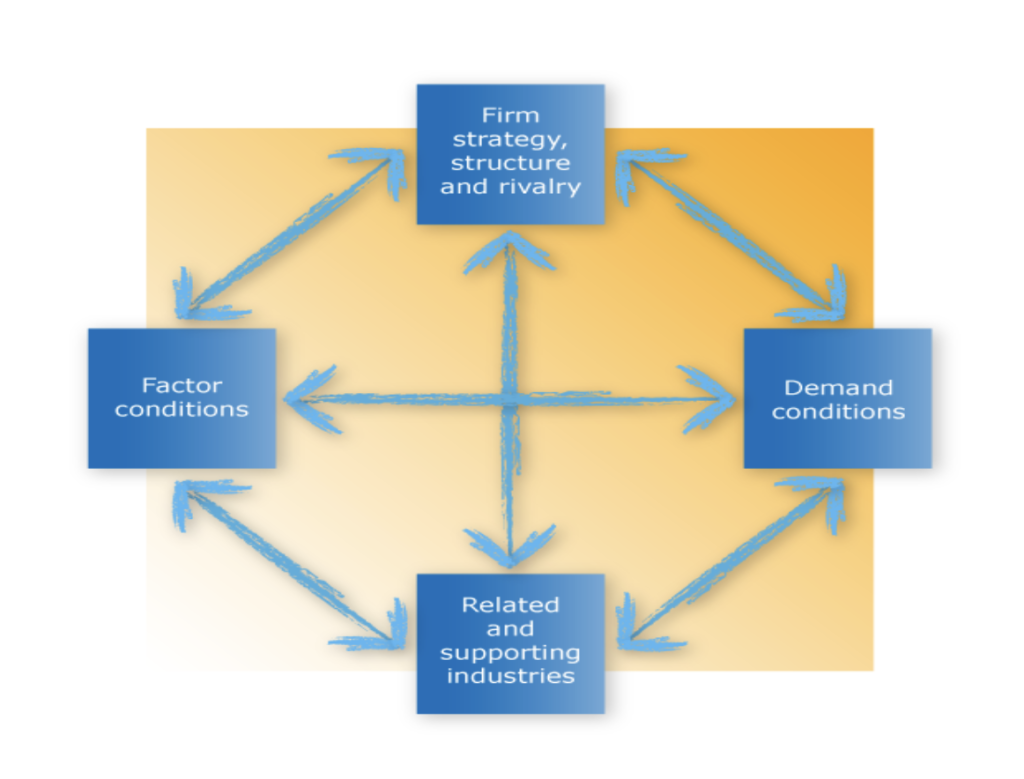
Samsung Electronics conducting a lot of manufacturing in Vietnam because of many reasons will be clearer in the following chapter (MCN and National Factors)
But this is a synopsis on the reasons of why the company produce a lot of products in Vietnam, because of Vietnam is proper for the company for example the labor wages are very cheap rather than chines labors also Samsung should defend profit margins as growth in sales of high –end handsets slows.
The economic growth that occurred in china that lead to wages inflation, make Samsung Electronics decided to increase its presence in Vietnam specially Vietnam is also very near to Korea so it’ll be close to the SAMSUNG supply chain, so Vietnam is proper for the company’s shifting from china
The trend of Samsung Electronics for shifting from china to Vietnam will likely accelerate for at least 2 or 3 years largely because the reasons I mentioned above, ” Lee Jung Soon,” who leads a business-incubation team of the Korea Trade-Investment Promotion Agency in Ho Chi Minh City. Said “Vietnam is really aggressive in fostering industries now”. So its words supported my point of view
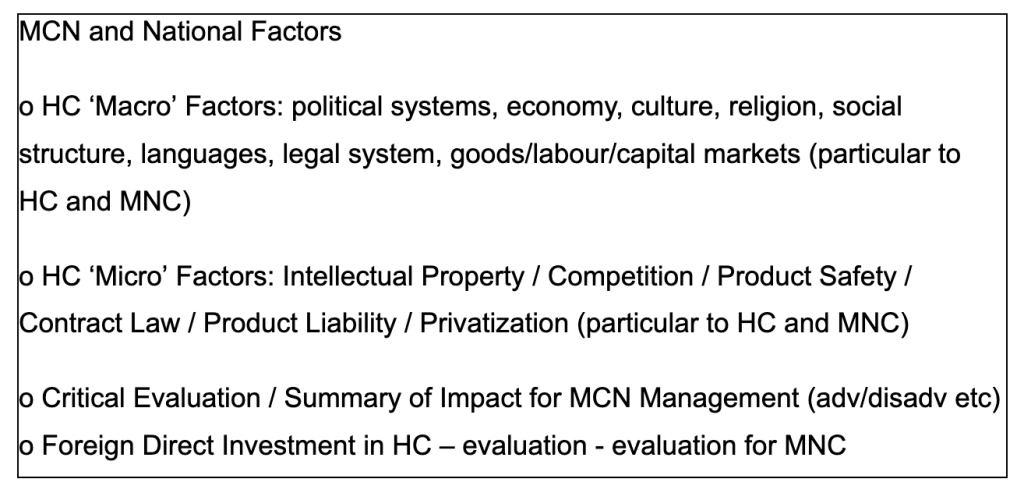
MCN and National Factors
o HC ‘Macro’ Factors: political systems, economy, culture, religion, social structure, languages, legal system, goods/labour/capital markets (particular to HC and MNC)
o HC ‘Micro’ Factors: Intellectual Property / Competition / Product Safety / Contract Law / Product Liability / Privatization (particular to HC and MNC)
o Critical Evaluation / Summary of Impact for MCN Management (adv/disadv etc) o Foreign Direct Investment in HC – evaluation – evaluation for MNC
This part will discuss the macro factors like political system, economy, culture good, labor and capital markets in Vietnam with the relation to Samsung after that I will discuss the micro factors like intellectual property, contract law, competition finalized with a summary of the impact for the management team of Samsung in Vietnam and evaluation of FDI in Vietnam with the relation to Samsung
Macro factors like political & legal system, economy, culture, good & labor and capital markets in Vietnam with the relation to Samsung
Samsung Electronics Co. built the world’s largest smartphone business by tapping China’s cheap and abundant workforce, but is now shifting output to Vietnam to secure even lower wages and defend profit margins as growth in sales of high-end handsets slows, The handset business is all about assembling well-sourced components. The most important thing is manpower
Vietnam is also near to Korea “the home country of Samsung” so it’ll be close to the suppliers
According to the political and legal system: the country is politically stable also it has a young and well-educated workforce that can ease Samsung’s investments there. Vietnam realized what it should do to rebuild its economy after the devastating war
The Vietnam’s congress approved Broad ECO. Reforms (Doi Moi or renovation). And this allow to attract the Multinational companies to invest in the country AS FDI also improved Vietnam’s business climate so this one of the reasons that make Samsung and other MNC invest a lot on Vietnam, by the way now Vietnam is one of the fastest growing economics in the world
Vietnam has great emphasize on private sector development and this considered as proper atmosphere for job creation
One of the Samsung’s production facilities in Vietnam as Samsung announced, “the Vietnam’s facility will improve its ability to supply displays to Samsung electronics which already makes mobile phones in the country
A subsidiary of south Korea’s SAMSUNG Electronics announced “that the company received approval to bullied a $1 billion display module assembly plant in Vietnam” and this considered as its first production facility in the country
SAMSUNG Electronics has been ramping up its production capacity in Vietnam for the reasons of lower cost in production according to the compressing competition in the smart phones
About the capital markets in Vietnam show that the domestic companies can’t earn a big money from exports so they spend much money to import for domestic production and this point will be discussed in the “SAMSUNG entry strategy in Vietnam” so this reflect that Vietnam also highly depend on FDI that’s is very good for SAMSUNG
Micro factors like intellectual property, contract law, competition, and others in Vietnam with the relation to Samsung
Intellectual property rights
Vietnam realized the importance of protecting the intellectual property rights that include trademarks and services marks plus the copyright and the industrial design.
(NOIP) is the responsible for the registrations of intellectual property for any foreign company that invest in Vietnam so SAMSUNG did that reverberations and obligations in the copyright office that controlled by the Ministry of Culture and Information
CONTRACT LAW
Hanoi – SAMSUNG Electronics received an approval from Vietnamese authorities to build the factory that produce the smart phones and tablets
The approval allows the south Korean technology giant, which already has 2 major manufacturing bases in Vietnam to expand production of key components to meet growing demand for smart phones as well as the other electronic products in a way that achieve cost competitive
Competition
The rivals like Huawei technologies and Lenovo group Ltd Represent a major challenge to Samsung Electronics especially in Mid- to low tier products
Intel Group considered one of the main competitors to SAMSUNG Electronics In Vietnam.
Intel co. is the world’s largest chipmaker, opened a $1 billion assembly and testing in Ho Chi Minh City in Vietnam on 2010. Also Nokia has its factories In Vietnam that producing Asha smartphones & features handset. Also one of the biggest rivals to SAMSUNG Electronics is LG Electronic Inc that has a big existence in Vietnam, also LG building 400,000m2 complex to make
Televisions & appliances about $1.5 billion as a part of LG investment plan in Vietnam so LG represent a big threat and challenge to SAMSUNG Electronics TV production in Vietnam. Definitely SAMSUNG Electronics has a big presence in Vietnam and the company has High market share in Vietnam
The role of the game now is measured by how much market share the company can gain over its rivals
The production capacity or the production volume of SAMSUNG Electronics in Vietnam is very big and for example the SAMSUNG factory that located in “country’s northern province of Bac Ninh ”can produce screens for 48 million mobile devices annually
Impact for SAMSUNG management – FDI in Vietnam
International diversification is a basic and the most important principles in the business world. In the past decade
Diversification is a strategy that allow to increase profits through selling new products in a new market, actually it has advantages & dis advantages of the company, diversifying internationally is a concept to enhance the value of the company which is source of FDI to gain economic of scale &economic of scope
SAMSUNG using Global procurement, the company looking for potential suppliers that’s committed to enhance the product development, Company culture, plus the contribution to the Global society, so SAMSUNG and suppliers as well as the manufacturers cooperate to conduct the best product
Global procurement not only reduce the production cost but also enhance the productivity, Samsung Electronics built the world’s largest smartphone business by tapping China’s cheap and abundant workforce, but is now shifting output to Vietnam to secure even lower wages and defend profit margins as growth in sales of high-end handsets slows, The handset business is all about assembling well-sourced components, Lee Seung-woo said. The most important thing is manpower also when Samsung conducted international trade, which also produced of FDI investment in Vietnam, both the company and Vietnam gained advantages. Vietnam is very proper to SAMSUNG to be as HC.
After I discussed the macro & micro factors of Vietnam so I will represent the impact on Samsung management from Vietnam as well as the facilities from Vietnam and the benefits on both
One of the main benefits on SAMSUNG Electronics management as well as in Vietnam that the company move to expand its production base in Vietnam specially the country is undergoing a swift economic transition exports of computers parts and specially the smart phones by this both gained benefit that’s Vietnam beginning to overtake the exports of coffee & garments and start to export smart phones and other electronics rather than before that was happened with the other electronics and telecommunications companies that has an investments in Vietnam but in the case of Samsung Electronics the Vietnam’s exports has a rapid increase that totalized 31.8 billion on 2013 and this considered as 24% of Vietnam’s total export
More than 50 % from the 2012
(Wall street journal Updated July 3, 2014 5:01 a.m. ET)
As I said in the previous paragraphs o the assignment that SAMSUNG Electronics has a big investment in Vietnam specially the company has started to shift from china to Vietnam
About one –third of the Global smartphones markets of SAMSUNG Electronics may eventually produce as many as 80 % of its handset in Vietnam
Vietnam conduct a policy that attract FDI investment so it provide many facilities to Samsung to invest in Vietnam like the low taxes as well as flexible contracts law and others
(KPMG)
KPMG considered as a largest professional service firm in Vietnam that established since the country opened the doors to FDI, KPMG has an active office in HANOI and it has more than 800 professional employees. Its functions are: providing services such as “ auditing, tax, plus working as an advisor to the government as well as to the MNC that want to enter the Vietnam’s Market so KPMG has a role with Samsung in Vietnam
A bit of disadvantages
Samsung realize that international diversify may occur complexity of the enterprise that can increase the cost of entering new market like the complexity with new administrative structure that may increase the information processing also it’ll have more management challenges but because of the benefits that SAMSUNG Electronics gain from enter Vietnam that I discussed above, all of these disadvantages aren’t valued
SAMSUNG ENTERY STARTEGY IN VIETNAM
AS I mentioned in SAMSUNG background that show that SAMSUNG Group is not only SAMSUNG Electronics so SAMSUNG group has a mix of entry strategy in Vietnam
Samsung Group want to implement complex infrastructure, bullied projects and global strategic partnerships and the company selected Vietnam to be the first strategic partner and Samsung arranged an important visiting to Vietnam that was between the president of Samsung, CEO and operator of the project and the Prime Minister and the minister of planning and investment of Vietnam
The deals that occurred between Samsung Group and Vietnam’s government is prompting to be as a part of Vietnam’s national power development and about Samsung Group the company will cooperative and developing the infrastructure of Vietnam that include Hanoi urban development and the national shipyard management normalization project
The deals that happened between Samsung and Vietnam that include the development the infrastructure of Vietnam will also make a joint venture strategy with Korea
Also about SAMSUNG Electronics shifting output to Vietnam to secure even lower wages and defend profit margin this strategy called strategic partnership, the company has employs approximately 40,000 workers in Vietnam also the company has a large scale of R&D center
The company’s investment in the production facilities that located in Vietnam is skyrocketing year after year, for example the company second plant in Vietnam, which is built in February 2014 at an investment of 2.22 trillion won (US$2.11 billion) and The target from this plant to take the place of its factory in China and it’s planning on an additional investment of 1.11 trillion won (US$1.06 billion) in another plant in the Yen phong industrial complex
At the same time the company is seeking to cut production costs in Korea by asking its partner firms to lower their component supply costs. Those have pointed out that SAMSUNG Electronics has made such requests on a rolling basis while asking for bigger markdowns for some of the firms
Finally about SAMSUNG Electronics strategy in Vietnam that the company on the way to replace its presence in china to Vietnam By the
“ Strategic partnership”
5) conclusion
SAMSUNG as MNC is always seeking for international diversification the strategy that allow the company to increase profits through producing in a new market so as I mentioned SAMSUNG Group Has a partnership with Vietnam as well as SAMSUNG ELECTRONICS has the same strategic partnership in its entry strategy in Vietnam because of it realized that Vietnam is the excellent solution because of Vietnam is proper for Samsung for example the labor wages are very cheap rather than Chinese labors also Samsung should defend profit margins as growth in sales of high –end handsets slows. And as we can conclude how the company has worked in Vietnam and what are the facilities that taken from Vietnam as well as the macro and micro factors in Vietnam that help SAMSUNG Electronics and SAMSUNG Group to gain all of that high profits in Vietnam as well as the projects that Samsung group are working with the Vietnam’s government plus the potential projects that will conduct it
Finally as we can conclude from the assignment that SAMSNG and Vietnam gain a very big benefits from the partnership that occurred between both.
Appendix.
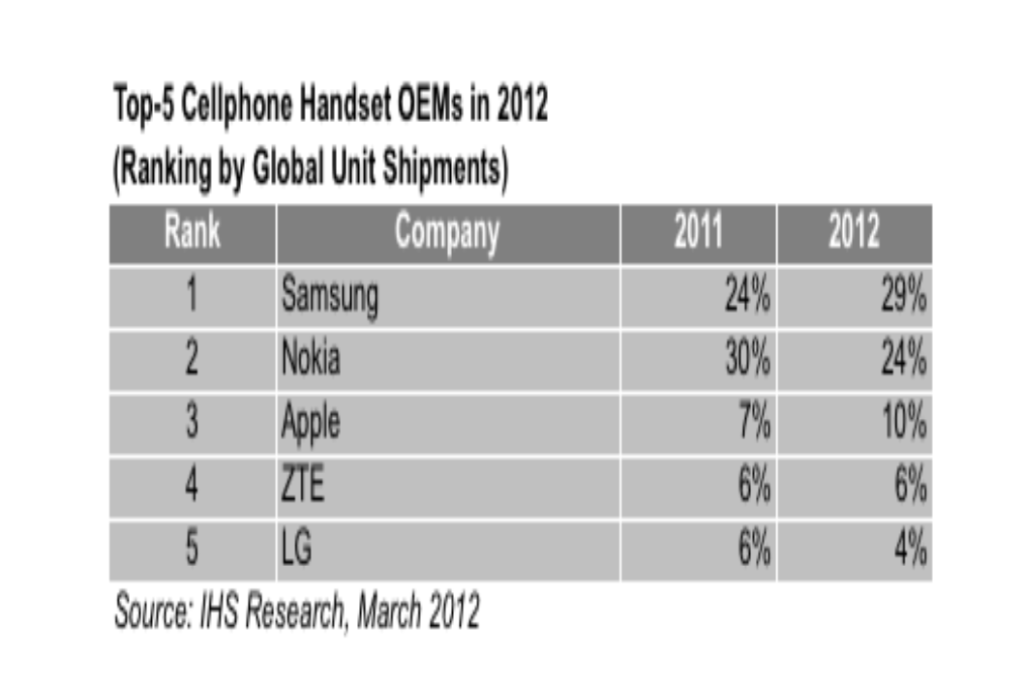
This is from UK essays that support my point of view on choosing Vietnam as HC to SAMSUNG http://www.ukessays.com/essays/economics/international-trade-of-samsung-electronics-economics-essay.php
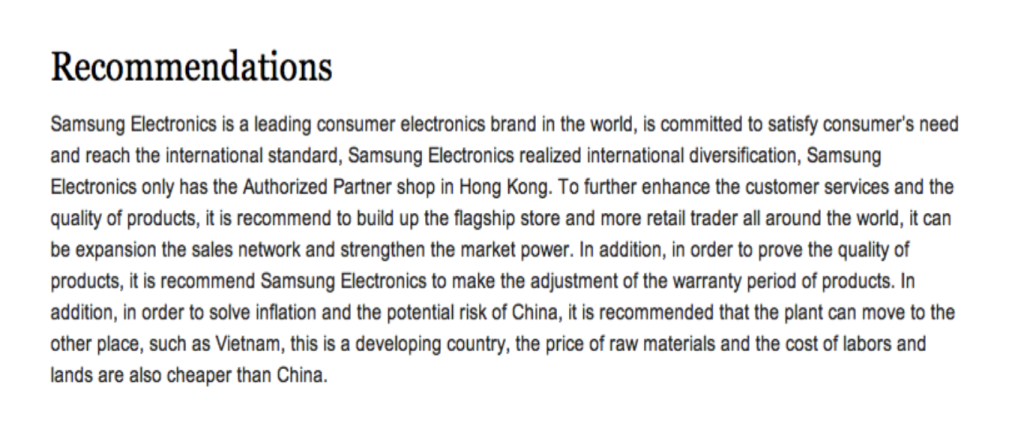
Article about Samsung in Vietnam
http://tuoitrenews.vn/business/15267/70-of-samsung-smartphones-made-in-vietnam
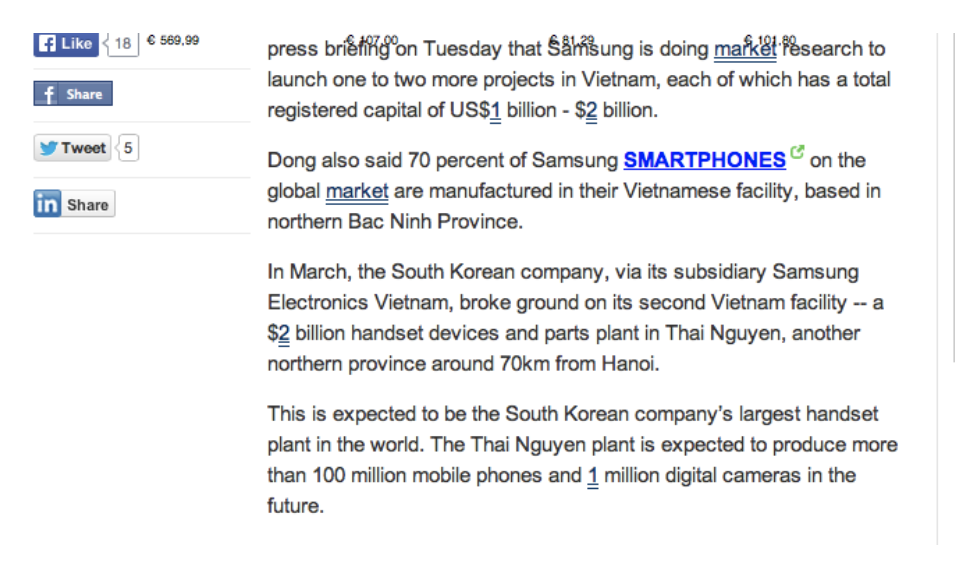
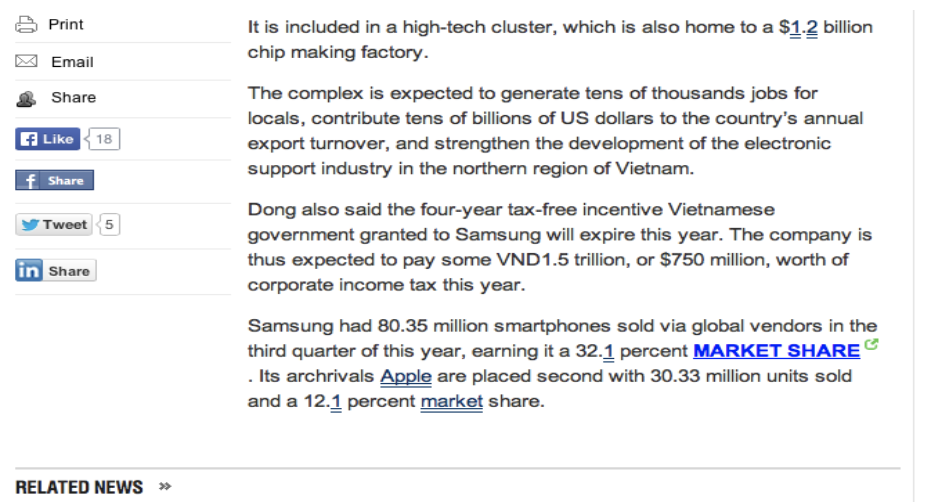
- Bibliography / References
samsung background avialable at www.samsung.com.
http://www.planetpdf.com/planetpdf/pdfs/samsung_presskit2_duffj.pdf
Vietnam background available at
culture in Vietnam avialble a thttp://geert-hofstede.com/vietnam.html
Globalization o Drivers and
o benefits and shortcomings of Globalization for Samsung and Vietnam available at
Book Global marketing a decision oriented approach fifth edition svend Hollensen
BOOk International Business-competing in the global market place 8E (ch 1 Globalization theory – Globalization in market and production
http://www.ukessays.com/essays/economics/vietnamese-economy-good-or-bad-economics-essay.php
http://www.businessweek.com/companies-and-industries
http://www.businessweek.com/articles/2013-04-04/samsungs-year-abroad
http://mystoriesinkorea.blogspot.it/2007/04/globalization-lesson-from-samsung.html
MNC and global institutions impact of Global institution on Samsung and Vietnam
http://www.ukessays.com/essays/economics/vietnamese-economy-good-or-bad-economics-essay.php
http://www.reuters.com/article/2014/07/03/us-samsung-elec-vietnam-factory-idUSKBN0F807220140703
http://www.business-in-asia.com/wto_vietnam_impacts.html
International trade theory available at
Book International Business-competing in the global market place 8E (ch 5 international trade theory
Samsung shifting up from china to Vietnam available at
http://www.bloomberg.com/news/2013-12-11/samsung-shifts-plants-from-china-to-protect-margins.html
http://www.taipeitimes.com/News/biz/archives/2013/12/13/2003578891
National factors
http://online.wsj.com/articles/samsung-wins-license-to-invest-1-billion-in-vietnam-1404356966
Macro and micro factors
http://globaledge.msu.edu/countries/vietnam
http://globaledge.msu.edu/countries/vietnam/statistics
http://globaledge.msu.edu/countries/vietnam/economy
http://globaledge.msu.edu/countries/vietnam/government
http://globaledge.msu.edu/countries/vietnam/culture
http://online.wsj.com/articles/samsung-wins-license-to-invest-1-billion-in-vietnam-1404356966
Impact on SAMSUNG management – FDI in Vietnam
Recommendations to Samsung to move from china to Vietnam available at
http://www.ukessays.com/essays/economics/case-study-on-samsung-economics-essay.php
http://www.talkvietnam.com/2014/05/the-fdi-driven-economy/
Advantages and dis advantaged on Samsung management
http://www.ukessays.com/essays/economics/case-study-on-samsung-economics-essay.php
http://www.reuters.com/article/2014/07/03/us-samsung-elec-vietnam-factory-idUSKBN0F807220140703
KPMG the professional service company in Vietnam available at
https://www.kpmg.com/vn/en/services/tax/documents/vietnam%20market%20entry_final_back%20cover.pdf
SAMSUNG entry strategy in Vietnam
Available at overview on
Global marketing a decision oriented approach fifth edition svend Hollensen
BOOk International Business-competing in the global market place 8E (ch 1 Globalization theory – Globalization in market and production
Class slides and notes……..
Outbound Summit Cairo

Outbound Summit Cairo
Ahmed Ragaie as a Cord Digital Founder invited to attend the Outbound Summit in Cairo with 5 persons from his choice . This event highlighted the company’s commitment to industry excellence and innovation https://outboundinvestment.com#
Founders Live Africa Prime Time Finals

Founders Live Africa Prime Time Finals
Parts from Ahmed Ragaie Pitch with Q&A for his company ” Cord Digital ” at Africa Regional Finals – Founders Live Prime Time Dec 6, 2024
I entered that Competition as the Founder/CEO of Cord Digital company. The company has secured the highest number of votes at the prestigious Founders Live Africa prelude voting stage and was in the road to be the champion of Africa event , just 2 votes from Ke-Massa Food from Ethiopia،, as some supporters of Cord Digital voted for it some minutes before the official time of the voting and the event organizers announced that in the live video… That issue had some negative feelings , but it was a good experience and congrats for the winner and wish him all the best.
</div
Pitch with Chinese Investors

Pitch with Chinese Investors
Some parts of my bussines pitch of my company ” Cord Digital ” with Chinese investors at the Global Entrepreneur Summit – HICOOL 25-08-2024. We wish all success for all entrepreneurs.
Ahmed Ragaie Ended 2024 with a prize

Ahmed Ragaie Ended 2024 with a prize
Ahmed Ragaie Ended 2024 with a prize from the Innovation & Entrepreneurship Competition for Overseas Talents 2024 – Hangzhou – China,
We would like to thank them for the honor and cash prize.💫
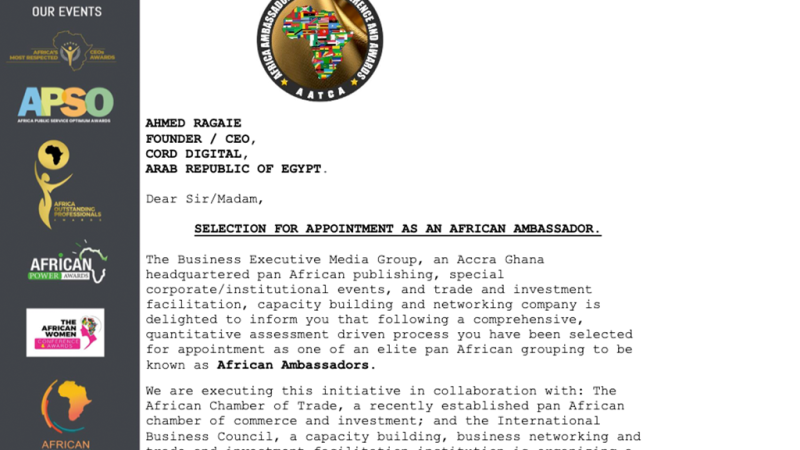
Ahmed Ragaie, will be present at a distinguished occasion Ghana
Ahmed Ragaie, will be present at a distinguished occasion in Accra, Ghana. This ceremony honors Mr. Ragaie’s noteworthy contributions and dedication to the profession, marking a crucial turning point in his career.

Why Ahmed Ragaie One Of The Best Strategic Marketing Consultant
Unlocking Success with Strategic Marketing Consulting: Ahmed Ragaie Expertise
In today’s competitive business landscape, effective marketing strategies are essential for growth and sustainability. As a strategic marketing consultant, Ahmed Ragaaie stands out in helping businesses navigate the complexities of marketing to achieve their goals. This article explores the importance of strategic marketing consulting and how Ahmed Ragaaie’s expertise can elevate your brand.
What is Strategic marketing consultant?
Ahmed Ragaiee Strategic marketing consultant involves assessing a company’s marketing strategies and providing tailored solutions to enhance performance. This approach focuses on long-term planning, market analysis, and aligning marketing efforts with business objectives. With the right consultant, businesses can identify opportunities, mitigate risks, and optimize their marketing investments.
Why Choose Ahmed Ragaaie?
1. Tailored Strategies
Ahmed Ragaaie as a Strategic marketing consultant understands that each business is unique. He takes the time to analyze your specific needs, industry trends, and target audience. By developing customized marketing plans, Ahmed ensures that your strategies resonate with your audience and drive results.
2. Data-Driven Insights
In the age of information, relying on data is crucial. Ahmed leverages advanced analytics to provide insights into consumer behavior and market trends. This data-driven approach allows businesses to make informed decisions, ensuring that marketing efforts are both effective and efficient.
3. Holistic Approach
Ahmed’s expertise goes beyond just traditional marketing. He integrates digital marketing, branding, and customer experience into his strategies. This holistic approach ensures that all aspects of your marketing work together to create a cohesive brand presence.
4. Proven Track Record
With years of experience in the marketing sector, Ahmed Ragaaie as a Strategic marketer has a proven track record of helping businesses achieve their goals. His success stories speak volumes, showcasing his ability to turn challenges into opportunities.
Benefits of Working with a Strategic Marketing Consultant
1. Increased Efficiency
By streamlining marketing efforts, Ahmed helps businesses save time and resources. His strategic insights enable companies to focus on high-impact activities that drive growth.
2. Competitive Advantage
In a crowded marketplace, standing out is vital. Ahmed’s strategies help businesses differentiate themselves from competitors, attracting more customers and increasing market share.
3. Enhanced Brand Awareness
A strong brand presence is essential for success. Ahmed’s expertise in branding and marketing ensures that your business not only reaches its target audience but leaves a lasting impression.
Conclusion
In a world where marketing plays a pivotal role in business success, partnering with a strategic marketing consultant like Ahmed Ragaaie can be transformative. His tailored strategies, data-driven insights, and holistic approach empower businesses to thrive in a competitive environment. If you’re ready to take your marketing to the next level, consider working with Ahmed Ragaaie to unlock your brand’s potential.
Watch More About Global marketing strategist

Best International Marketing Consultant In Egypt
Unlock Global Potential with Ahmed Ragaie: Your International Marketing Consultant
In an era where businesses are increasingly looking beyond their borders, the role of an international marketing consultant has never been more critical. Ahmed Ragaaie is at the forefront of this field, helping companies craft strategies that resonate in diverse markets worldwide. This article explores the importance of international marketing and how Ahmed’s expertise can drive your business’s global success.
What is International Marketing Consulting?
International marketing consulting involves developing strategies tailored to meet the needs of global markets. This includes understanding cultural differences, market dynamics, and consumer preferences across various regions. An effective international marketing consultant helps businesses navigate these complexities to expand their reach and enhance brand visibility.
Why Choose Ahmed Ragaaie as Your International Marketing Consultant?
1. Cultural Sensitivity and Awareness
Ahmed Ragaaie brings a wealth of experience working across different cultures and markets. He understands the nuances that influence consumer behavior, ensuring that your marketing strategies are culturally relevant and impactful.
2. Data-Driven Market Insights
Ahmed as a International marketing consultant employs comprehensive market research techniques, analyzing trends, competition, and consumer data. This data-driven approach enables businesses to make informed decisions and adapt their strategies to meet the demands of international markets effectively.
3. Tailored Marketing Strategies
Every market has its unique challenges and opportunities. Ahmed as a International marketing consultant crafts customized marketing plans that align with your business goals while addressing local market conditions. This tailored approach ensures maximum engagement and effectiveness.
4. Proven Track Record of Success
Ahmed has successfully guided numerous businesses in launching and expanding their operations internationally. His proven methodologies and strategic insights have consistently resulted in increased market share and brand recognition.
Benefits of Working with an International Marketing Consultant
1. Expanded Market Reach
With Ahmed’s as a International marketing consultant expertise, businesses can identify and penetrate new international markets, opening doors to untapped customer bases and revenue streams.
2. Enhanced Brand Positioning
A strong global presence requires a well-defined brand strategy. Ahmed helps companies position their brands effectively in international markets, ensuring they stand out amidst competition.
3. Improved Return on Investment (ROI)
By optimizing marketing strategies for specific markets, Ahmed maximizes the efficiency of marketing budgets. This leads to better returns on investment and sustainable growth.

Conclusion
In a globalized economy, having a knowledgeable international marketing consultant like Ahmed Ragaaie can be instrumental in achieving your business objectives. His cultural expertise, data-driven insights, and tailored strategies empower brands to thrive in diverse markets. If you’re ready to unlock your business’s global potential, partner with Ahmed Ragaaie to navigate the complexities of international marketing and drive your success.
Watch More About Marketing promotion strategiest

Best Global Business Consultant In Egypt Ahmed Ragaie
Transform Your Business with Ahmed Ragaaie: Your Global Business Consultant
In today’s interconnected world, businesses face unique challenges and opportunities that require a strategic approach to succeed on a global scale. As a distinguished global business consultant, Ahmed Ragaaie specializes in guiding organizations through the complexities of international markets. This article explores the significance of global business strategist and how Ahmed’s expertise can help your business thrive.
What Does a Global Business Consultant Do?
A global business consultant provides expert advice and strategies to help companies expand their operations internationally. This includes market analysis, cultural adaptation, regulatory compliance, and the development of effective marketing strategies tailored to diverse audiences. The goal is to enable businesses to navigate the global landscape successfully and achieve sustainable growth.
Why Choose Ahmed Ragaaie as Your global business strategist?
1. Comprehensive Market Insights
Ahmed Ragaaie as a global business strategist possesses extensive knowledge of global markets. He conducts thorough market research to identify trends, competitive landscapes, and consumer behaviors in various regions. This insight allows businesses to make informed decisions and capitalize on emerging opportunities.
2. Cultural Expertise
Understanding cultural nuances is crucial for successful international operations. Ahmed’s experience working in diverse markets equips him with the skills to help businesses adapt their strategies to resonate with local audiences, ensuring effective communication and brand acceptance.
3. Strategic Planning and Implementation
Ahmed as a Global business consultant & global business strategist excels at developing tailored strategies that align with your business goals. He works closely with clients to create actionable plans that address specific challenges, whether it’s entering a new market, optimizing operations, or enhancing customer engagement.
4. Proven Success in Global Expansion
With a track record of helping businesses successfully expand internationally, Ahmed as a Global business consultant and global business strategist has demonstrated his ability to drive growth and enhance profitability. His strategic insights and hands-on approach ensure measurable results.
Benefits of Partnering with a Global Business Consultant
1. Access to New Markets
Ahmed helps businesses identify and penetrate new international markets, enabling them to diversify their revenue streams and reduce dependence on local markets.
2. Improved Operational Efficiency
With Ahmed’s guidance, businesses can streamline operations and optimize processes for international success, leading to increased productivity and cost savings.
3. Enhanced Brand Reputation
A well-executed Global business consultant enhances brand reputation and recognition. Ahmed ensures that your brand maintains a consistent and positive image across different markets.
Conclusion
In an era where global competition is fierce, having a knowledgeable global business consultant like Ahmed Ragaaie can be a game-changer for your organization. His comprehensive market insights, cultural expertise, and strategic planning capabilities empower businesses to navigate the complexities of international markets successfully. If you’re ready to take your business to the next level, consider partnering with Ahmed Ragaaie as a global business strategist to unlock your global potential and achieve sustainable growth.

What Is Pitching In Business From Ahmed Ragaie
Mastering the Art of pitching in business: Insights from Ahmed Ragaie
In the competitive world of business, effective pitching is crucial for securing investments, partnerships, and clients. Whether you’re an entrepreneur seeking funding or a professional aiming to sell an idea, mastering the art of pitching in business can significantly impact your success. Ahmed Ragaaie, an expert in business strategy and communication, shares essential insights on how to craft and deliver compelling pitches that resonate with your audience now we will know the answer to what is pitching in business?
what is pitching in business?
pitching in business refers to the presentation of an idea, product, or business plan to persuade an audience to take a specific action—be it investing, collaborating, or purchasing. A successful pitch not only conveys the core message but also engages the audience emotionally, fostering interest and trust.
Key Elements of an Effective pitching in business
1. Know Your Audience
Understanding your audience is the foundation of a successful pitching in business. Ahmed emphasizes the importance of tailoring your message to meet the specific interests and needs of your listeners. Researching their backgrounds, preferences, and pain points can help you connect on a personal level.
2. Craft a Compelling Story
Storytelling is a powerful tool in pitching in business. People remember stories better than statistics. Ahmed advises framing your pitch as a narrative that highlights the problem, solution, and potential impact. This approach not only makes your pitch more relatable but also creates an emotional connection with your audience.
3. Be Clear and Concise
Clarity is key. Avoid jargon and overly complex language. Ahmed recommends keeping your pitching in business focused and concise, ideally under 10 minutes. Highlight the most critical points, such as your unique value proposition and market opportunity, to engage your audience quickly.
4. Showcase Your Passion
Passion is contagious. When you believe in your idea, it shows. Ahmed encourages pitch presenters to convey their enthusiasm and commitment. Authenticity can significantly influence your audience’s perception and willingness to engage.
5. Prepare for Questions
Anticipating questions demonstrates your deep understanding of your topic. Ahmed suggests preparing for potential objections and concerns your audience may have. This readiness not only builds credibility but also shows that you value their input and are open to dialogue.
6. Follow Up
The pitching in business doesn’t end when you finish speaking. Following up with your audience is crucial. Ahmed advises sending a thank-you email and providing additional information or answers to questions that arose during your presentation. This reinforces your professionalism and keeps the conversation going.
Conclusion
Mastering the art of pitching in business is essential for anyone looking to succeed in business. Insights from Ahmed Ragaaie highlight the importance of knowing your audience, crafting a compelling story, being clear and concise, showcasing passion, preparing for questions, and following up. By implementing these strategies, you can improve your pitching skills and increase your chances of achieving your business goals. Whether you’re seeking investment or trying to sell an idea, effective pitching can open doors and create lasting opportunities.
Learn More About Strategic marketing consultant
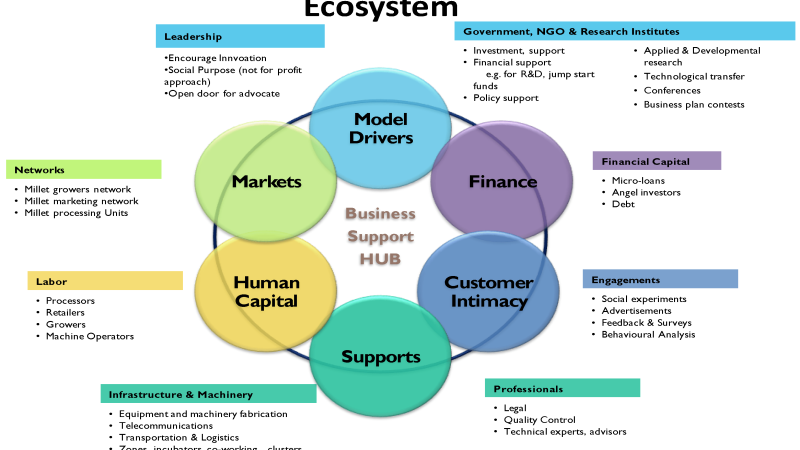
How To Build A Startup Ecosystem With Ahmed Ragaie
How to Build a Startup Ecosystem: Insights from Ahmed Ragaie
In the dynamic world of entrepreneurship, creating a thriving startup ecosystem is essential for fostering innovation, attracting investment, and supporting the growth of new businesses. As a seasoned expert in business strategy, Ahmed Ragaaie shares valuable insights on how to build a successful startup ecosystem that nurtures creativity and drives economic development now we will know the answer about How to build a startup ecosystem.
Understanding the Startup Ecosystem
A startup ecosystem consists of various stakeholders, including entrepreneurs, investors, mentors, accelerators, educational institutions, and government entities. These components interact to create a supportive environment for startups, fostering collaboration and innovation. A robust ecosystem not only benefits individual startups but also contributes to the overall economic health of a region.
Key Steps to Building a Startup Ecosystem
1. Foster a Culture of Innovation
Creating a culture that encourages experimentation and risk-taking is fundamental to a successful startup ecosystem. Ahmed emphasizes the importance of inspiring creativity through events, workshops, and networking opportunities. Engaging the community in discussions about innovation can help to ignite new ideas and collaborations.
2. Engage Stakeholders
Building a startup ecosystem requires collaboration among various stakeholders. Ahmed advises connecting entrepreneurs with investors, mentors, and industry experts. This can be achieved through networking events, conferences, and online platforms that facilitate knowledge sharing and partnership opportunities.
3. Provide Access to Funding
Access to capital is crucial for startups to thrive. Ahmed recommends establishing relationships with venture capitalists, angel investors, and financial institutions. Additionally, creating local funding initiatives or grant programs can help to support startups in their early stages, reducing barriers to entry.
4. Support Education and Training
Investing in education and training is vital for developing the skills needed in the startup community. Collaborating with universities and educational institutions to offer entrepreneurship programs, workshops, and mentorship can equip aspiring entrepreneurs with the knowledge and skills necessary to succeed.
5. Leverage Technology and Infrastructure
A strong technological infrastructure is essential for supporting startups. Ahmed suggests investing in co-working spaces, incubators, and innovation hubs that provide resources and support for entrepreneurs. Additionally, promoting access to technology can help startups scale their operations effectively.
6. Encourage Policy Support
Government policies play a crucial role in shaping the startup ecosystem. Advocating for policies that support entrepreneurship, such as tax incentives, regulatory reforms, and simplified business registration processes, can create a more conducive environment for startups to flourish.
Conclusion
Building a vibrant startup ecosystem is a complex but rewarding endeavor. With insights from Ahmed Ragaaie, it’s clear that fostering a culture of innovation, engaging stakeholders, providing funding access, supporting education, leveraging technology, and encouraging policy support are key elements for success. By implementing these strategies, communities can create an environment where startups thrive, driving innovation and economic growth. If you’re looking to cultivate a successful startup ecosystem, consider partnering with Ahmed Ragaaie to leverage his expertise and insights.
Learn More About what is pitching in business

The Best Global Marketing Strategist In Egypt
Elevate Your Brand with Ahmed Ragaie: Your Global Marketing Strategist
In an increasingly interconnected world, businesses must adopt comprehensive marketing strategies that resonate on a global scale. As a global marketing strategist, Ahmed Ragaaie possesses the expertise necessary to help brands navigate international markets, adapt to diverse consumer preferences, and achieve sustainable growth. This article delves into the significance of global marketing strategies and how Ahmed’s unique approach can benefit your business.
Understanding Global marketing strategist
A Global marketing strategist Ahmed Ragaaie involves creating a unified marketing plan that addresses the complexities of operating in multiple countries. This strategy considers cultural differences, economic factors, and local market conditions, ensuring that a brand’s message is relevant and impactful across various regions.
Why Ahmed Ragaaie is Your Go-To Global Marketing Strategist
1. Cultural Expertise
Ahmed understands that effective marketing goes beyond language; it requires cultural sensitivity. With extensive experience in various markets, he tailors strategies that respect and reflect local customs and preferences, ensuring your brand resonates with diverse audiences.
2. Comprehensive Market Analysis
Before crafting marketing strategies, Ahmed as a Global marketing strategist conducts thorough market research. This includes analyzing competitors, identifying trends, and understanding consumer behavior in target regions. His insights enable businesses to make informed decisions and adapt to changing market dynamics.
3. Integrated Marketing Solutions
Ahmed’s approach to global marketing is holistic. He integrates digital marketing, social media, content marketing, and traditional advertising to create a cohesive strategy. This ensures that your brand maintains a consistent voice and message across all platforms and regions.
4. Proven Success Across Borders
With a track record of successful campaigns in various international markets, Ahmed Ragaaie has helped numerous businesses expand their reach and increase their global presence. His results-driven approach has consistently delivered impressive outcomes.
Benefits of Partnering with a Global Marketing Strategist
1. Increased Brand Recognition
A well-executed global marketing strategy enhances brand visibility and recognition. Ahmed ensures your brand stands out by adapting your message to suit local markets while maintaining a consistent global identity.
2. Access to New Markets
Expanding into new markets can be daunting. Ahmed’s as a Global marketing strategist expertise allows businesses to identify opportunities and navigate the complexities of new territories, helping to mitigate risks and maximize potential rewards.
3. Consumer Engagement
Understanding your audience is crucial. Ahmed as a Global marketing strategist employs data-driven insights to tailor marketing efforts, ensuring they resonate with local consumers. This level of engagement fosters brand loyalty and drives sales.
Conclusion
In today’s global marketplace, having a global marketing strategist like Ahmed Ragaaie can be a game-changer for your business. His cultural expertise, comprehensive market analysis, and integrated marketing solutions empower brands to thrive on an international stage. If you’re ready to elevate your brand and expand your reach, consider partnering with Ahmed Ragaaie to develop a strategic marketing plan that transcends borders and drives success.
Watch More About International marketing consultant
The Best Marketing Promotion Strategiest

The Best Marketing Promotion Strategiest
Amplify Your Brand with Ahmed Ragaie: The Marketing promotion strategiest You Need
In the fast-paced world of business, effective Marketing promotion strategiest is essential for standing out and driving growth. As a seasoned marketing promotion strategist, Ahmed Ragaaie specializes in crafting innovative strategies that capture attention, engage audiences, and convert leads into loyal customers. This article explores the importance of marketing promotion and how Ahmed’s expertise can elevate your brand.
Understanding Marketing Promotion Strategy
From Marketing promotion strategiest ahmed ragaaie Marketing promotion encompasses a variety of tactics designed to communicate a brand’s message and drive sales. This includes advertising, public relations, sales promotions, and digital marketing. A well-rounded promotion strategy is vital for increasing brand visibility, attracting new customers, and retaining existing ones.
Why Ahmed Ragaaie is Your Ideal Marketing promotion strategiest
1. Creative Campaign Development
Ahmed Ragaaie Marketing promotion strategiest excels at developing creative marketing campaigns that resonate with target audiences. His innovative ideas and out-of-the-box thinking ensure that your brand stands out in a crowded marketplace.
2. Data-Driven Decision Making
In today’s data-centric world, making informed decisions is crucial. Ahmed utilizes analytics to assess campaign performance, audience behavior, and market trends. This data-driven approach allows for continuous optimization, ensuring maximum impact.
3. Integrated Marketing Solutions
Ahmed as a Marketing promotion strategiest understands that a successful promotion strategy requires a cohesive approach. He integrates various marketing channels—including social media, email marketing, and traditional advertising—to create a unified brand message that reaches customers at multiple touchpoints.
4. Proven Track Record of Success
With a wealth of experience in the marketing industry, Ahmed as a Marketing promotion strategiest has a proven track record of implementing successful promotion strategies. His campaigns have helped numerous businesses increase brand awareness, drive sales, and foster customer loyalty.

Benefits of Working with a the best Marketing promotion strategiest
1. Enhanced Brand Visibility
Effective promotion strategies significantly boost brand visibility. Ahmed’s expertise ensures that your brand captures attention and remains top-of-mind for potential customers.
2. Increased Customer Engagement
From Marketing promotion strategiest Engaging customers is key to building lasting relationships. Ahmed crafts strategies that foster interaction, encourage feedback and create a community around your brand.
3. Higher Conversion Rates
Well-executed promotion strategies lead to higher conversion rates. By targeting the right audiences with the right messages, Ahmed helps turn prospects into loyal customers.
Conclusion
In a competitive business environment, having a skilled Marketing promotion strategiest like Ahmed Ragaaie can make all the difference. His creative approach, data-driven insights, and integrated strategies empower brands to thrive and achieve their marketing goals. If you’re ready to amplify your brand and drive success, consider partnering with Ahmed Ragaaie to develop a promotion strategy that elevates your business to new heights.
Watch More About Global business consultant

Global Supply Chain With The Local Marketing Talent – part 9
This research released by Ahmed Ragaie in 2014 during his masters degree from ESE, University of Buckingham.
To get a full understanding of the research about “ Global Supply Chain with the Local Marketint Talent “, Please read the articles from part 1 to part 9.
5.3 Discussion
This research conceptualizes the relation between marketing and SCM and the proposed framework moved this integration to more strategic level.
According to the theoretical perspective, the research proposed framework is important contribution within the existing knowledge on the relation between marketing and SCM and it’s developing this integration between both into more strategic level through the proposed framework which captures the integration between marketing and supply chain into business unit and moves them onto more strategic level. Integrating marketing and supply chain strategies involves the management of the following levels of integration:
- Strategic corporate, customer, and shareholder integration.
- Strategic supplier integration.
- Strategic marketing and SCM with the local marketing talent integration.
From the practical perspective, this research aims to providing guidelines to Multinational firms about the relation between marketing and SCM with integrating the local marketing talent into more strategic level, so this is a discussion about this issue:
According to the marketing and the trends in supply chain there are 10 games which changing the trends in the Global Supply chain, which can be listed on the following
- Customer service to customer relationship management
- Adversarial relationships to collaborative relationships
- Incremental change to a transformational agile strategy
- Functional focus to process integration
- Absolute value for the firm to relative value for customers
- Forecasting to end casting (demand management)
- Training to knowledge-based learning
- Vertical integration to virtual integration
- Information hoarding to information sharing and visibility
- Managerial accounting to value-based management
Figure 5.3 are the results from surveying more than 150 supply chain professionals in order to assess these trends and the figure will show us the changes of the results from 2000 to 2013.
Talent management which including marketing talent is becoming Cleary emerges as the linchpin required fro advancement in all areas.
Crating close relationships with customers enable the MNC to identify the long-term requirements, expectations and preferences of current and potential customers as well as it facilitate and evolving the operational configurations which help to deliver tailored supply chain with optimal profitability.
Improving the operational effectiveness for customers is highly desirable and it might be considered as building blocks toward competitive advantage.
The short time programs is simple and it easy to imitate but this performance is not suffice to sustain in a tough business environment so the strategic integration to the local marketing talent on a strategic level not only on short time operations and tactics is giggly required to sustain the competitive advantage.
In todays’ Global business MNC feel the need to cut expenses and this essentially requires evolving the local marketing talent. Many Firms have lack on the local marketing talent and in todays’ business the consumption or investment in humans is more important than consumption and investments on assets in order to developing a truly global mindset which will bring High return on investment. As well as MNC have to accelerate the evolving of talent in various different markets, in some countries the employee is highly educated and have an experience but not all of tem trained on the kills to working on MNC and as the research discussed that this actions will make high benefits in all the MNC, employee, Global business. The whole world characteristics
The researcher see that credibility is very critical issue in delivering the value to customers and to developing Marketing talent, without credibility the world will be without value, if you are working on some job as an employee obviously you’re waiting for results in front of your self also waiting for assessment from your Manager about what you did so this issue should be achieved in a very sensitive criteria and also to be very accurate in order to success and evolving the world Business also in all domains. In marketing field, the trust is essential in order to achieve customer loyalty. People should invest on themselves and always searching for smart solutions and innovative ideas out of the box but it have to be built on strong and serious basics. If you trust your self and have a strong belief to be creative you will do it either you’ll find help or not. The researcher recommends the Multinational firms to focus more on developing the global talent, which leverage also the local talent. Also loyalty is very important topic, which deserve to take in consideration so this also depends on credibility.
5.4 Limitations and future research directions
The research main topic lies on the global supply chain with the local marketing talent. This research is revolving on moving the integration between marketing and SCM for Multinational firms into more strategic level, so integrating local marketing talent with the global supply chain on more strategic level to set the research framework which occurred many questions which have beyond our scope but will hopefully stimulate further researches. IN order to move the integration between both into more strategic level. Integrating marketing and supply chain strategies involves the management of the following levels of integration:
Strategic corporate, customer, and shareholder integration &
Strategic supplier integration. & Strategic marketing and SCM with the local marketing talent integration.
To adopt the framework should investigate the relations between MKG and SCM. As well as in order to understand the relation between marketing and SCM which requires MNC to working toward customer value creation. The studies have to further investigate the impact of market orientation and supply chain orientation on the strategic decisions and choices for the MNC also the implementation process. It could be suggested that firms with simulations market and supply chain orientation to be more aligned on their marketing and supply chain strategies within the firm’s supply chain network. This research is focusing on local marketing talent as it’s play a vital role to move the integration between marketing and SCM into more strategic level. This research suggests that MNC should implement an integrated value chain approach, which could be based on strategic integration for the 3 levels that the proposed framework achieved. Further researches have to discover and investigate the link between the integrated marketing and SCM for the MNC as well as the strategic orientation of the collective supply chain also further issues about the adoption of wider SCM for evolving of a strategic perspective and explore the integrated value system management. This research is focusing on conduct the proposed framework on various different markets across the world so integrating local marketing talent into more strategic level is essential. To achieve this framework on various markets further researches have to suggest tools and strategies to developing the local marketing talent and suggest activities that could be important to move the strategic integration between marketing and SCM with integrating local marketing talent to more and more strategic level such as evolving the HR which concern on the supply chain talent and marketing talent also exploring concepts about the relation between marketing and SCM according to the dynamic global business and rapid changes on customer demands and perceptions. Finally the further research have to investigate the relation between economies of scale and scope with SCM and the local marketing talent and try to developing this relationship, For further expand in various markets across the world.

Global Supply Chain With The Local Marketing Talent – part 8
This research released by Ahmed Ragaie in 2014 during his masters degree from ESE, University of Buckingham.
To get a full understanding of the research about “ Global Supply Chain with the Local Marketint Talent “, Please read the articles from part 1 to part 9.
Conclusion and Recommendations
The main conclusion
Based on the findings obtained in this research, it is evident that supply chain management and marketing activities in organizations ought to be collaboratively approached. For multinational firms, the highly dynamic global environment necessitates a localized approach to the marketing activities in each country; which ought to be linked with the entire global supply chain of the firm. This study has revealed that customers prefer localized marketing approaches, and thus becoming necessary for firms operating in the global platform to consider integrating their supply chain with marketing systems to facilitate organizational learning. Concerning the studied organizations, Coca-Cola, Pepsi, and Nestle in Egypt, this study has revealed that the majority of customers are satisfied by the flow of their products (both new and existing) into the market through Hyper One supermarket. The purpose of this conclusion is not to show the marketing activities and strategies in different markets, which depend on customization. This isn’t the research’s main idea, because the research’s main idea revolves in the strategic integration between marketing and supply chain management which requires multinational firms to conduct customized and localized marketing approaches especially in FMCG, the main importance of this research to move the strategic integration between marketing and supply chain management to a more strategic level which involving integrating local marketing talents in global supply chain management design for the Multinational firms not only on the operational and tactics level but on a more strategic level. In this study, integrating local marketing talent with the global supply chain design for the multinational firms within the supply chain network is not only considered to be necessary to ensure that the organizations have sufficient marketing intelligence; which is quite necessary for effective supply chain management. But to move the strategic integration between marketing and supply chain management to a more strategic level within the supply chain network as the supply chain management is derived toward customer value creation and also the proposed framework facilitates the strategic integration between corporate, customers, and shareholders as well as the strategic integration between customers and suppliers which has a critical factor which is the integration between internal and external supplier which required integrating local marketing talent on global SCM for the Multinational firms on more strategic level to ensure effective information flow within the supply chain network.
While the integration between supply chain management and marketing may involve various firms in different countries, it was revealed in this study that firms must always uphold the legal frameworks provided in each country they operate. Meanwhile, the use of EDI and POS technologies was found to be quite useful in linking supply chains and marketing activities among the four case study organizations in this research. It was also revealed in this research that, integrating customer needs along the supply chain is a key factor contributing to customer satisfaction as it was revealed in this research as we observed that the customer segmentation is essential to set the supply chain management strategies across markets. Integrating local marketing with the global supply chain management design of multinational firms can lead to utilize the concept of economies of scale and scope on maximum usage through transferring this local marketing talent and conducting common advertising and marketing promotions which is more consistent within the Middle East Region and the example of Egypt, United Arab Emirates and Kuwait prove the availability and the high potential of success.
Finally in the main conclusion paragraph, we observed that the research questions have been answered within the body of the literature review and findings- data and analysis section as well as the interviews & surveys. We realized the importance of integrating the local marketing talent with the global supply chain management design and the proposed framework achieved and moving the integration between marketing and supply chain management to a more strategic level through the explanation of the factors within the framework, as well as we realized that we can extend market orientation to supply chain orientation and what are the best method that can capture the voice of customers on the local market through the survey and the data analysis which recommend the customization marketing approach on the local marketing specially on FMCG and the importance of local marketing talent. Also, we realized the qualitative and quantitative customer data through representing the role which they play and that supply chain management derived through customer value creation as well as the role of customer co–creation within the supply chain management, lastly, the research objective achieved through the research proposed framework and integration the local marketing talent with the global supply chain management design for the Multinational firms on a strategic level not only operation and tactics level. Also beyond this idea through transferring this local marketing talent. by discussing the relationship between multinational firms, local marketing talent, and the concept of economies of scale and scope.
5.2 Recommendations
As the global business environment and customers’ perceptions and demands are highly dynamic and have highly rapid change, Multinational firms shouldn’t think about performing on the traditional marketing and supply chain management. The strategic integration between marketing and supply chain management within an effective supply chain network is becoming essential in today’s global business, the integration between marketing and supply chain management should designed to deliver value propositions for different customer segments which are supported by strategic marketing and supply chain integration. The strategic task of this integration lies in how to translate the integration into delivering the customer value propositions and partitioning supplier approach, so the Multinational firms should set a strategic framework which integrates between corporate, customers, shareholders, and suppliers as well as the importance of integrating local marketing talent within this framework on a more strategic level. The strategic integration requires an effective supply chain network with local marketing talent. And this is what this research is seeking to achieve
Based on these findings, the recommendations section will be divided into 2 parts
- The FMCG multinational firms in Egypt and the Proposed Framework
- Local marketing talent
The following recommendations have been considered necessary for implementation on multinational firms operating in Egypt in the fast-moving consumer goods industry:
Multinational firms should source local talents to incorporate into their marketing teams to ensure that marketing intelligence is more accurate. This is because local marketers are more informed about the specific needs of the local consumers that a firm targets.
Firms operating in the global platform should put due diligence on the legal frameworks that influence their supply chain management and marketing integration process.
Firms with complex supply chains need to adopt automated supply chains through the use of technology (EDI and POS) to facilitate agility, quick response, and demand chain management in the entire supply chain.
.
If the multinational firm serving in different countries haven’t effective talent management especially marketing talent it will be forced to depend on consulting local consulting companies within the foreign market, for example how the firm transfer the product from U.S. A to Egypt for example, could have 25% difference from the firm bottom line just because for something like taxes or other legal or environmental regulation so the importance on how the firm can avoid this extra costs or other complex issues or dealing with the uncertainty issues, as well as the political situation that should be very clear to the firm, so evolving talent management especially marketing talent is essential especially In FMCG because of the reasons exist on the body of the research.
The timing is a very critical issue, intern, sales furcating is becoming an integral and huge part to success managing of the supply chain and keeping costs down, as moving products takes longer time in an international scale, so Multinational firms should be focusing on an effective way of the idea of how much that bulk inventory is going to sell, so deliver value to customers and satisfying them might need large inventory within effective supply chain network that lead the sales furcating that fulfill the sales expectations, and this should make the Multinational firms to evolving their local marketing talents within their foreign markets
One of the main research’s recommendations to multinational firms serving different markets; they shouldn’t assume too much that’s means it’s a big mistake if the multinational firm when considering international expectations makes too much guessing without accurate knowledge and statistical data & analysis, also this is not suffice it should depend on the local marketers which have high experience also they can deal with local marketing research company which can help their downstream local marketers through doing downstream marketing functions after taking the upstream vision and strategy from the local marketers, multinational firms should make sure that their partners within the supply chain network can sustain the business.
There are three steps to achieve a profit-centric supply chain which the multinational firm can conduct
Any firm all over the world is seeking to gain profit; focusing the supplied chin on profit enables the multinational firm to be aligned revolve common goals, which will be underachieving customer value creation.
Profit-centric supply chain execution including the activities, which are focusing on optimizing key financial matters like working capital and costs, revenues. By the way, with the traditional supply chain the concentration of moving goods being a secondary factor, this is a logical evolution of the supply chain which involves strategic scenario analysis and optimization to improve the firm’s financial and strategic position and also to improve the firm’s products.
According to multinational firms; capturing the advantages or the benefits of the profit centric supply chain requires the following levels which are highly recommended to multinational firms
- Product life cycle: as basic the product life cycle starting from introduction growth until the end production phase needs to be maximized in their lifetime financial contribution that will help the marketing and supply chain management to compete in the market
- Market life cycle: every market has a unique life cycle so multinational firms which are serving in various markets across the world to manage the different market life cycles for each market according to its characteristics such as promotions, pricing, and product strategies, the way in which the firms need to optimize the financial objectives to meet the variable cost which is highly recommended to the FMCG multinational firms.
- The main important point on which is relating to customer value creation and customer relationships which are essential for the strategic integration between marketing and supply chain management with integrating the local marketing talent because of this point multinational firms should consider all markets are local which they have their characteristics, so it requires from the multinational firms to set particulate structure, pricing, capacity distribution channels. Especially on the FMCG which this research is focusing on.
These are some tips to managing the profit-centric supply chain
Multinational firms should optimize the local profitability of the required products within the local market or the most prior products also they have to use strategic levers like promotions, pricing, supply chain as well as distribution channels, so to meet the strategic and financial goals for this local market, they should set additional products and services on the prioritized basis to encompass the entire product portfolio
One of the main important issues that supply chain management should be highly aware of it, the dynamic and rapid change of the global market, so multinational firms should respond quickly to these changes this requires to integrate the local marketing talent with their global supply chain management design also they should stay ahead of the local market with market-leading innovation and products which are highly required adaptation, customization as well as fine-tuned of the marketing mix, and products warehousing and logistics.
We can conclude that the successful local execution of the global supply chain management for multinational firms has significant benefits to the global firms and the local market. And this research explained that the proposed strategic framework has a positive effect on expanding marketing talent and transfer it to other countries which have similar culture and business environments which enable multinational firms to conduct more consistent advertising campaigns and integrated marketing communications to decrease the advertising costs, which was explained through the example of Egypt, United Arab Emirates, and Kuwait. Integrating the local marketing and management talent enables multinational firms to gain additional knowledge from the local market, which can be leveraged globally such as product design
These are also some recommendations to the Multinational firm’s global supply chain management.
Multinational firms have to set aspirational goals as well as connect between the daily work and supply chain contribution to their local community, which they live to evolve the supply chain management and marketing talent
The idea is not only to engage the local marketing talent on local operations issues but also on strategic issues and the research in the “discussion section” will view statistics and smart strategies on how to improve and evolve the local marketing talent and new synergies across best practices to more growth and inspiring the hearts and minds of the local marketing and supply chain talent for the Multinational firms on more strategic integration within the global supply chain network for the Multinational firms.

Global Supply Chain With The Local Marketing Talent – part 7
This research released by Ahmed Ragaie in 2014 during his masters degree from ESE, University of Buckingham.
To get a full understanding of the research about “ Global Supply Chain with the Local Marketint Talent “, Please read the articles from part 1 to part 9.
4.5 Testing and analysis of the third hypotheses (A strategic integration framework)
There’re 3 point of view could be differentiated which include the integration of inter -functional, process, and business concept which can move the integration between marketing and supply chain management on more strategic level.
The proposed framework builds on these perspectives, which captures the integration between marketing and supply chain into business unit and moves them onto more strategic level. Integrating marketing and supply chain strategies involves the management of the following levels of integration:
- Strategic corporate, customer, and shareholder integration.
- Strategic supplier integration.
- Strategic marketing and SCM with the local marketing talent integration.
Introduction on the proposed framework
When we describe these three levels of integrations as they related to each other, we have to put the first and second levels under the third level that’s “strategic integration between marketing and SCM with the local marketing talent “to realize and understand well the research main idea and the additional factor that added on the framework that’s local marketing talent.
First level of integration (strategic corporate, customer, and shareholder integration)
The firm’s objectives of the business or unit should be aligned for customer and share holder value creation specially on the large firms, as we understood from the literature review chapter as well as from the pervious paragraphs that, the integration between Marketing and supply chain management are mainly focusing on linking the customer value creation and market performance, but as we mentioned that specially on the large companies such as the Multinational firms, the focusing should includes the shareholder value creation, actually this can be done through the strategic integration between marketing and supply chain management, so from this point we argue that this strategic integration could mediate the link between customer value and shareholder value creation specially both are already sharing common and same asset base which they build on, basically we can judge and evaluate marketing on how it develop and improve the share holder value as well as the main important criteria which we can measure the marketing performance is; its efficiency on customer value creation. From this point we can conclude that customer and channel relationships shouldn’t only seen as an objects of marketing actions because of, it should be seen as a strategic asset of the firm which have to be well established, according to the supply chain which have highly concern from the top management at any firm, on its relation with marketing , we can measure the supply chain performance as a partner within the supply chain network through its efficiency on improving the short term cost effectiveness (Lacefield, 2007) , so from this point the risk on destroy the shareholder value as (Christopher and Ryals 1999) discussed that supply chain as an element to improving the short term profit which based on the supply chain can destroy a shareholder value if they undermine a firm’s financial health in the longer term. Some researchers develop the framework in the way of linking market based asset on market performance and ultimately shareholder value and also others extended the principles and link between asset, performance and value to include the integration between marketing and supply chain management, and this research are developing the framework to including the strategic integration between marketing and SCM with the local marketing talent, as the Multinational firms serving diverse markets which have diverse customers so the strategies ,operations should be achieved through effective information flows within the supply chain network. Hence the role of the local marketing talent emerges, which will be discussed on more details on the third level of integration within the proposed framework of this research.
Come back to the first level of integration within the proposed framework of this research which is (strategic corporate, customers, and shareholders integration)
Shareholder value is created when the firm’s performance within the market generate high returns which is compensate the investments of the total expenses and costs which occurred through the investors as well as a premium which more than compensate for the additional risk incurred. We can say that the strategic assets considered a basis for the shareholder value and this is because of they facilitate and enable the firms to generate strategies and implement it which enhancing its effective and efficient performance within the market as well as ensure the competitive advantage, but this strategic assets have no value unless it converts and transmitted into the customer value creation. From this point we can say that marketing and supply chain management build on the same strategic assets that is (customer, channel, supply chain) relationships. To realize this point we have to understand the marketing and supply chain roles on this issue.
Supply chain relationships comprise upstream and downstream relationships with customers and suppliers and on this point, the researcher will discuss it on the second level of integration as the marketing is playing a vital role in ensuring the information flow within the supply chain network as well as the Supply chain management and marketing have a significant effect on balance and link between customers and suppliers. Marketing is doing a very important role which can be described on the marketing channel relationships take a downstream perspective on the firm’s integration with the partners within the supply chain network, as the researcher mentioned on above that marketing department play a vital role in ensuring the information flow as on this chain the Multinational firms will deal with internal and external suppliers either locally or Globally. Hence the role of local marketing talent play a vital role which facilitate the Multinational supply chain network activities in different markets across the world which requires high and professional skills as well as good understanding of the local culture and business environment in the foreign market.
Marketing and supply chain strategies are linking these assets to the key shareholder value driver of accelerated cash flow, both doing an effective activities beside accelerating cash flow such as improving the cash flow operation as well as reducing the changes or vulnerability of the cash flow for instance marketing strategies as one of its main important objectives to enhancing and developing the long term relationships with customers and through this, the firm can reduces the time for market penetration and for the multinational firms which the time is considered as an important element, the local marketers can enhance the Multinational firms ability to reduce the time on penetrate the market then the cash flow will be accelerated also the local marketers could developing the customers loyalty and this also will enhance the cash flow or reduce the volatility in cash flow among the stability in the relationships with the local customers that need close relationships according to their different culture and behaviors. Supply chain strategies in turn also play a vital role on this through it can comprise the time and shorter end to end pipeline time so it has a positive significant effect on the relationships between the parties within the supply chain network. Finally the integration between marketing and supply chain on foreign market will enable the Multinational firm to have high response to the market rapid changes which lead to reduce the risks and uncertainty or lost the market share and revenues. When we talking about the strategic customers that; the Multinational firm should make the customers as we mentioned above that customers are a strategic asset which should build and enhanced on their relations with the firm through the integration between marketing and supply chain within the supply chain network, we can say that customers value creation process considered as the starting point for the segmentation as the customers characteristics has highly dynamic changes so the integration between marketing and supply chain management should move into more strategic level and this research suggest that local marketing talent which should be integrated with the global supply chain management design in more strategic level not only operational and tactics level, as the information flows and customization of products and services play a vital role on enhancing the Multinational firms competitive advantage within the global market.
Also strategic customers including focusing in customer needs and value creation approach should be aligned with the firm’s value propositions, as the research idea emphasized that the Multinational firm should understand the different customer characteristics and needs through the local marketing talent so this required understanding of the customer value creation process as well as it aims to maximizing the co-creation value across target customer segments which considered as the main objective that drives the close interaction between marketing and supply chain management.
The value co-creation perspective based on the customer is always co-producer, that’s means the customer is interact with the firm, we can say that customer value creating process as the starting point for segmentation.
The customer value creation can be described as a set of activities which done by the customer in order to achieve a specific goals, when the company seek to increase the degree of customer integration. It should develop the customer value creation by using a specific process such as enhancing the customer capability to utilize the available resources in higher degree of efficiency and effectiveness such as according to the marketing perspective; customers can use the brand in their own advertising. And according to the supply chain perspective; short lead-time and short cycle time requires in delivering the products or services to the customers. We can conclude that, the ideas of the customer value as co-created value involving well understanding what are the features of the customer value and translated to the value proposition as the customer demand is highly dynamic and highly changed as well as has differences from market to another, so according to the Multinational firms which is serving in different markets, the local marketing talent play a vital role to link between the marketing’s perspective & process as well as supply chain’s perspective & process within the supply chain network as the information flows is highly utilized.
To summarize the strategic corporate, customers, and shareholders integration, we can say that the strategic integration between marketing and supply chain management should link between focusing with customers value and shareholders value creation through what the researcher mentioned above on this paragraph.
Second level of integration (Strategic supplier integration)
On this level of integration, the firm’s co-creation, which based customer segmentation is integrated with the approach of supplier’s value creation, it includes synchronized downstream customer and upstream suppliers segmentation. On this strategic supplier integration we can find many researcher which emphasized on the integration between customer and supplier, the companies which with upstream and downstream integration outperform others, so we can conclude that to handle this issues the company should be aware of a range of performance indicators such as market share, profitability and return on investments as well as return on assets or overall customer service, some researchers such as (Lee, 2002) adopt logic strategy which designed to balance the uncertainties on customer demand with supply side uncertainties, Lee said that from an integration perspective; the supplier strategy cannot be suffice in express in terms of the closeness and quality of the social relationship (e.g. Gundlach et al., 1995). . On this point, this research is seeking to continue on this concept, which is that social relationships are not sufficed for strategic supplier integration. To realize the researcher point of view according to this point, we have to remember the interview, which the researcher did with the material planner director of Almaraie Company, which is in a joint venture partnership with PepsiCo. We can say that according to the supply chain’s point of view; the marketing of the firm is considered as the internal customer of the supply chain and logically according to the marketing perspective the supply chain is considered as the internal supplier, as the research discuses the integration between marketing and supply chain within supply chain network also we have to put the external supplier of both marketing and supply chain in high consideration which requires effective information flows. Hence the Multinational firm, which is serving in different markets, should improve the local marketing talent in its foreign market to ensure the ability to meet the dynamic customer demand as well as the led time cycle and the example of PepsiCo and Almaraie Company is the best example, which can describe the researcher point view on this issue.
Also there’s a very important point that the Multinational firm should take in consideration which is customizing the products or services that offering on a particular market which already demonstrated high level of excellent operations provides the opportunity to the supplier to become an integral part of a customer’s business, as the supply chain management is highly depend on close relationship with customers so the way on how to customized the products or services in a particular market which is also should be aligned and consistent with the firm’s general strategy and ideology is the key point of success which requires high skills instrument and one of the main important instrument is the local marketing talent.
To summarize the main purpose of the strategic supplier integration level, we can say that the extension of the integration between customers and suppliers can be done among strategic supplier partitioning approach, which is supported by the experimental evidence of an effective performance on the vertical upstream and downstream collaboration which is depend on high interactive between marketing and supply chain management which is in turn requires effective local marketing talent which will be discussed in more details on the third level of integration (Strategic marketing and SCM with the local marketing talent integration) which the research proposed framework built on.
Third level of integration (Strategic marketing and SCM with the local marketing talent integration)
On this research’s proposed framework, we have to put the first and second levels under the third level to realize and understand well the research main idea and the additional element that added on the framework that’s “local marketing talent”. But before reviewing the marketing talent we have to talk about the marketing and supply pipeline strategy integration.
The strategic task of this level of integration lies on the questions of how the marketing and SCM define customer co-creation propositions as well as the approach of supplier partitioning which could be translated into the process of delivering the value that ensure the effective activities from the customer to supplier or from supplier to the customer according to the co-creation value which should be with the configuration process engaged on the integration marketing and supply chain management, from the market conditions and experience. The researchers considered the customer as an factor who engaged in co-creation of value because of the customer has the ability to improve the performance of the firm while ensuring that the effectiveness of the underling marketing strategy is not only including the marketing and supply chain management field through linking the respective strategies to the customer and market segment characteristics which considered as the emphasizes of integrating marketing and supply chain strategies to achieve the competitive advantage. To make the idea more clear we can say that marketing is focusing on the activities of marketing mix such as product, price, place, promotions. The marketing strategy types based on interrelated decisions regarding these divers instruments such as aggressive marketers, mass marketers, marketing minimizer and value marketing strategies and all theses instruments to deliver the value to the customer, and logically depend on the supply chain which is focusing on enhancing the duration of life cycle and lead time and mainly focusing on the quality of raw materials that’s also depend on the market characteristics both integrating to deliver the value to the customer that depend on the market segment characteristics that is different from market to another which is highly depend on the local marketing talent because of the integration between marketing and supply chain need to be orchestrated across different markets, when the researcher said orchestrated logically it refers to the need to be driven from the local marketing talent point of view and driving the operations required highly skills and proficiency to gain the advantage which could be mixed with the advantage of quick response from the local marketing talent to the highly dynamic customers demands
The following figure can explain the integration between marketing and supply pipeline strategy.
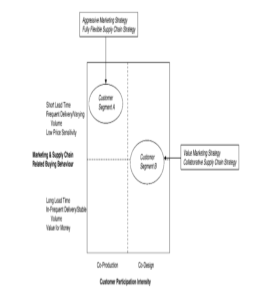
To explain the figure idea on brief its about that every segment required a specific marketing and supply pipeline strategy which is need either high responses or high understanding of the market characteristics from the marketing and it provides short lead time with varying delivery volume, low price sensitivity or the other option provide long lead time, stable delivery volume, which both depend on different strategy of supply chain which both strategies should be aligned and integrated within the supply chain network .
To summarize the integration between marketing and supply pipeline strategy, we can say that it reflects the process of configurations which are designed in order to deliver the value propositions for the different customer segments supported by strategic marketing and supply chains’ decisions and we can highlighted on the word of decisions to conclude that; the strategic integration not only depend on implementation or acting activities but it’s highly depend on decisions which requires proficiency and high skills within effective supply chain network.
Now we are moving to the marketing talent, which will take also more discussion on the last section of this research. It can be described as the following:
Marketing talents are concentrating on everything related to the market and competition involving the value of talent that enabling the firm to cover the benefits of economical areas, customer satisfaction, competitors, quality productivity, cycle time, market capitalization as well as costs and revenues, rationally those activities can’t be achieved by computerized techniques so it should be achieved trough talented persons, so the firm’s process to improve the management and marketing talent not only including hiring the most qualified and valuable employee but focusing on how to retain them and the main important to improve their skills and knowledge, so the local marketing talent should be integrated with the global supply chain management for the multinational firms in more strategic level as it considered as a vital player on the strategic integration between marketing and supply chain management , as the world business is becoming highly dynamic and the customer demands and perception have a rapid change so the Multinational firms which are serving in different countries and the efficiency of the managing the multinational firms relationship can be measured through managing relationships with targeted customer segments as we conclude from the research the importance from this in order to more strategic integration between marketing and supply chain management, so the Multinational firm should respond on this dynamic customer demand’s, through focusing on customer relationships and cross functional integration which requires from the Multinational firms more focusing on their customers outside the firms and shoring up the emphasize on cross functional processes inside the firm and this can be achieved through strategic integration between marketing and supply chain management as we realized from the above paragraphs the importance of this integration on a strategic level as well as we realized that marketing talent play a vital role to move this strategic integration to more strategic level. Talent marketing is a subset of talent management which is becoming highly needed for advancement in all areas, so the local marketing talent as its importance to be integrated within the supply chain management design for the Multinational firms that will gain advanced benefits in the particular market which the multinational firm is serving on also the potentially to be exploited to other markets which has similar cultures and business environment which will be discussed on the fourth Hypotheses.
Finally on the third hypotheses by conducting this proposed framework the integration between marketing and supply chain management will move into more strategic level which leads the multinational firms to gain more competitive advantage, customer loyalty and more strategic benefits through improving the local marketing talent to be an integral part within the global supply chain management design for the multinational firm not only on the operational and tactics level but on a strategic level.
4.6 Testing and analysis of the fourth Hypotheses (The strategic integration between global supply chain management for Multinational firms and the local marketing talent will lead to utilizing the concept of Economies of scale & scope in the best usage)
When the multinational firms focusing on developing local marketing talent fled. It can gain tremendous benefits from this not only on the particular single market which the local marketing has been developed within, but it can exploit the local marketers who are becoming more proficient and advanced skills through engaging in the global supply chain management design of the Multinational firms.
First, we have to discuss why supply chain management tanning to knowledge-based learning “talent management”: one of the main requirements of supply chain talent; is finding and hiring as well as evolving the talented people then it can placing them in suitable roles. Successful firms are the firms that can gain a competitive advantage that mainly depends on the changing supply chain game, the firm has to be professional to choose the right skills in the right place, and according to the research’s main idea, the multinational firms should focusing a lot on this field specially on FMCG.
During the great recession talent management took a back seat within a lot of firms in different industries, but on the FMCG, the firms decided to move aggressively against this trend, however, they layoff huge numbers of their employee and decreased about 10% of the overall salaries but they set an effective strategy and plans to enhancing and evolving the talent management. Logically almost of the firms did this because they realized the importance of talent management in this industry, especially in the large firms – Multinational firms serving in various markets, local marketing talent should be a priority and should be integrated into their global supply chain management design on a strategic level as the research mentioned above, we can say that the multinational firms can exploit the marketing talent by transferring it into another market which has similar characteristics and business environment and by this it can also reducing its overall costs, this point take us to the concept of economies of sale and economies of scope which is very relevant to achieving this point.
Multinational firms which serve a lot of different customers in different countries across the world. Could gain benefits from the concept of economies of scale and scope through transferring the experience gained from one country to another country in terms of similarity in culture, customer characteristics, and business environment. From this point, we can conclude that if the firm is concerned with improving the local marketing talent in different nations, it can exploit the experience that the marketer could gain and use it in another country, that shares a similar culture, customer characteristics, and business environment and according to the industry which the research is focusing on “FMCG” firms can exploit the local marketer in Egypt in a lot of countries within the Middle East Region especially they are sharing one language and similar cultures Egypt considered as Hollywood of the Middle East, through this, the multinational firms can use the Egyptian celebrities and make common campaigns that can be suitable in all countries within the Middle East Region and also make its campaign more consistent as well as reducing advertising costs, so this required great collaboration and integration between marketing and supply chain management on a strategic level.
When we measure the similarities between for example Egypt, United Arab Emirates, and Kuwait we can find, the 3 countries share a common language, traditions, and a proper percentage of cultural and customer characteristics similarities, as the researcher mentioned above that Egypt is controlling the media in the Middle East and it considered as the Hollywood of Middle East, so this concept has high potentially to be achieved and the percentage of the success is very high.
This is a comparison between cultures in Egypt, the United Arab Emirates, and Kuwait.

So we can conclude that when multinational firms enhance and evolve the local marketing talent, that is serving within, it can gain a competitive advantage in this particular country as well as beyond this country.

Global Supply Chain With The Local Marketing Talent – part 6
This research released by Ahmed Ragaie in 2014 during his masters degree from ESE, University of Buckingham.
To get a full understanding of the research about “ Global Supply Chain with the Local Marketint Talent “, Please read the articles from part 1 to part 9.
4.4 Testing and analysis of the second hypothesis (The strategic integration between marketing and global supply chain will lead to more competitive advantage and increase customer service & loyalty leading to increased outcomes).
Besides the use of self-fulfilling questionnaires, the researcher also conducted interviews with experts in supply chain management and marketing activities who were all directors of the respective departments in the three selected organizations (Coca-Cola, Pepsi, and Nestle) in Egypt. When asked what they think about the link between marketing activities and supply chain management, all the marketing and supply chain directors acknowledged that supply chain management and marketing are inseparable. For instance, the marketing director of Pepsi indicated that, ‘…there is no doubt that supply chain activities must be informed by the market conditions….’ Similarly, the supply chain director of Coca-Cola indicated that, ‘…. to be sincere, it is impossible to achieve sustainable marketing activities without a plausible supply chain….’ To a previous study conducted by Juttner, Christopher & Godsell (2010), integrating supply chain management operations with marketing activities is necessary because market needs dictate ‘what’ is to be supplied and ‘how’ the final products will be supplied to the markets.
When asked whether market orientation should be extended to supply chain management orientation, the majority of the interviewees revealed that extending marketing orientation to supply chain orientation is necessary for sustainable customer orientation. For example, the marketing director of Nestle indicated that ‘…. it is necessary to understand the market dynamics and extend them within the supply chain….’ Similarly, the supply chain management director of Coca-Cola noted that market dynamics informs any changes in the supply chain, and thus market orientation usually informs supply chain orientation. As such, organizational learning was considered in this study to be a collaborative approach in the supply chain and marketing sides. For instance, the supply chain management director of Pepsi revealed that ‘…. given the link between supply chain management and marketing, then definitely learning in the entire organization must be a collaborative approach in both the sides…’ This clearly shows that marketing management and supply chain management ought to be collaboratively managed within global organizations. In this regard, both qualitative and quantitative customer data was found to be quite useful in predicting customer value along the supply chain.
Among the best practices that this study revealed to be quite useful in facilitating the integration of marketing strategy and supply chain management is technology within an organization’s value chain. Among all the interviewees in this study, the use of electronic data interchange (EDI) and point of sale (POS) technologies were revealed to be among the most useful supply chain management systems that help in linking the entire supply chain with the demand chain management system. For instance, the supply chain management director of Nestle noted that ‘…using technology in integrating supply chain with the demand side is quite useful, like the use of electronic data interchange and a point of sale software….’ As a result, inter-functional integration was considered to be necessary to ensure that marketing, logistics, and manufacturing are linked; to facilitate the integration of marketing and SCM processes. As revealed by the marketing director of Coca-Cola, ‘…linking marketing with logistics and manufacturing facilitates a holistic approach towards marketing efficiency…
The use of local marketing workforce (talents) was also highlighted in this study to be necessary to enable an organization to be able to understand the needs of the communities they serve better. Through the use of local talent, it becomes easier for an organization to be able to coordinate supply chain management with marketing activities. Based on Wolf (2013) ideas, local staff members are usually preferable in multinational firms because of their ability to integrate local values into the organizational value chain; and thus promote a better relationship between an organization and the communities around them. This explains why it is necessary to integrate local marketing talents into the supply chain management activities of multinational firms to enable the firms to be in a position to meet the specific needs of the local markets in the most effective manner as the researcher sees that integrating the local marketing talent with the global supply chain for the MNC in more strategic level will facilitate the information flows between the partners within the supply chain network.
When asked about whether the integration of SCM and marketing can lead to quick response, all the interviewees acknowledged the significance of integrating the entire supply chain with marketing activities to enhance quick response. As indicated by the supply chain director of Pepsi, ‘…when marketing intelligence information is shared in timely manner to the upper echelon of the supply chain, then it becomes easier for manufacturers to respond quickly to any changes in demand…’ This brings in the concept of the agile supply chain where unnecessary inventories are avoided within the supply chain when the market information is shared within the supply chain (Banker, 2009). For example, the marketing director of Nestle indicated that ‘…when sufficient information about the market demand is shared promptly within the supply chain, then it becomes easier to control inventories within the supply chain….’ This leads to demand chain management where marketers tend to receive the right amount of stocks from the supply chain side based on the demand. These findings seem to corroborate with a previous study conducted by Juttner, Christopher & Godsell (2010) which revealed that, integrating supply chain management and marketing is necessary for prospective organizations in the currently globalized environment.
However, this study revealed several challenges that face the integration of supply chain management and marketing. As indicated by the supply chain management director of Pepsi, ‘…supply chain complexity in overseas markets resulting into bullwhip effect is a major factor that has been interfering with agility in many supply chains…’ With numerous middlemen, some companies find it difficult to track their products along the supply chain, and subsequently source information from the market upstream in the supply chain (Flint, 2004); posing a potential challenge in ensuring cohesive supply chain integration with marketing activities. Another key challenge was indicated by the supply chain management director of Nestle who pointed out that, the highly dynamic consumer needs make it difficult for firms to make forecasts on demands; thus making it difficult to balance between the demand chain and the processes in the upper echelon of the supply chain. To counter the challenges related to market dynamics, (Dubais, Hulten & Pedersen ,2004) suggest the use of an automated supply chain management system that enables instant sharing of information upstream or downstream along the supply chain. For example, in cases of any unexpected changes in the market, retailers can share the information quickly with the manufacturers and thus enhance quick response within the system.
Nevertheless, this study revealed that there are some legal issues that multinational firms must adhere to when integrating their supply chain management and marketing activities. Among such issues is the competition law, which inhibits large firms from making collaborations. In addition, the legal practitioner of Coca-Cola also noted that ‘…ethical sourcing of raw materials is also necessary, while also providing honest promotions to the customers…’ In multinational companies, the legal practitioner of Pepsi indicated that ‘…legal and cultural diversity is a key factor which firms must consider when planning a marketing or supply chain design….’ This clearly showed that all the activities related to supply chain management and marketing have legal obligations, and thus organizations must always act within the stipulated legal frameworks in the countries they operate in.
When we go to the interview with the martial planner director of Almaraie. And it was very important; especially since Almaraie is in a joint venture with PepsiCo.
First let’s introduce this partnership the partnership is a joint venture which 51% Almarai & 49% PEPSICO, by the way, they share a specific Juice Beyti that was owned by Beyti company before the company sold to Almaraie and PepsiCo. But they still offer Beyti juice in the Egyptian market until now and this will be clear within the body of the interview.
To understand well the conclusion of the interview we have to present the interview in some detail:
When the researcher asked her about the way of working in the supply chain department and the challenges. She told me if they have a launch on a tide time, the Supply chain department can go to external suppliers, so we can conclude that the policy of SCM regardless dealing with internal suppliers or external suppliers, but the main importance is the quality and the lead time and this what the researcher is focusing on this research, the strategic integration within supply chain network, as we know marketing and sales considered as internal customers of the supply chain, so supply chain department ‘is trying to achieve the marketing and sales needs as well as the marketing and sales departments should respect the timeline and business flows of supply chain network. When the researcher asked her if the marketing department as an internal customer to the supply chain department can change or alter the supply chain design at any time regardless of the terms and the conditions of working. She answered that the Supply chain department takes the plans and instructions from the marketing department but in case the marketing needs specific products from the supply chain department for a particular event, the operation of that has to be on a marital plan in six or seven months before the event on also she said to me that, the supply chain can bring everything from local external suppliers or global external suppliers or mix between both, but everything have to be aligned within the supply chain management “the supply chain network”.
Now we‘re moving to the main important point about the collaboration between Almaraie and PepsiCo.
The researcher asked her about the nature of this partnership on the way of working and communication between all partners within the supply chain network, she said PepsiCo. Deal directly with the marketing department of Almaraie, as the marketing department considered an internal supplier to Almaraie’s supply chain department so the information flow within the supply chain network plays a vital role in ensuring the efficiency of the activities which enables all the partners within the supply chain network to represent their perspective, also she said the only direct communication between the supply chain department of Almaraie and PepsiCo Lies on one or two meetings between PepsiCo’s board director and Almaraie’s supply chain department during the year. Hence the role of the marketing department to ensure the efficiency of the information flows within the supply chain network. Also when the researcher asked her about the main challenges that face Almaraie’s supply chain, she said that PepsiCo. Could restrict specific lead-time and specific external suppliers on Almaraie’s supply chain to bring some of the raw materials of some sort” tastes” within (Tropicana juice) from a specific supplier either locally or globally so Almaraie’s supply chain can face some problems in case of the external supplier don’t respect the timeline that PepsiCo needs in its product (Tropicana), by the way, the marketing department is also responsible to achieve this operation so the effective information flow is a very critical player within the supply chain network, when the researcher asked her about what Almaraie’s supply chain do to prevent the problems that could face when dealing with a specific external supplier which PepsiCo Choose it? She said that Almaraie’s supply chain started to set an internal strategy to prevent these problems from happening such as setting higher safety stock also they could increase the led time, also the researcher asked her in case the external supplier had big problems in delivering the raw materials to Almaraie’s supply chain, what Almaraie will do? She said also PepsiCo. Haven’t access to handle these problems and Almaraie’s supply chain with the marketing department are the only 2 partners responsible for handling all of these problems in front of PepsiCo, so if the problems with the external supplier that Almaraie deals with aren’t solved, then Almaraie’s supply chain and marketing department can recommend PepsiCo another external supplier so again PepsiCo. Their Investigation on this external supplier requires effective investigation from the local marketers of PepsiCo, Hence the improvement of the local marketing talent of the Multinational firms is very important and also can play a multi-role within one country or other countries and the researcher will discuses it in the following hypotheses of the research.
Coming back to the relation between all partners within the supply chain network, the Researcher asked her which suppliers PepsiCo Prefers local or multinational external suppliers. She said both is acceptable to PepsiCo, but the main important is the quality so we can conclude that the global norms within the integrated / Interdependent economic system “ Global economy system” ease a lot of procedures in today’s business.
Finally the researcher asked her about the partnerships that occurred between Almaraie and PepsiCo. Still offer “Beyti Juice” in the Egyptian market that was owned for “Byeti company before it sold to Almaraie and PepsiCo, she answered that Both companies realized that Beyti juice” has a high market share in the Egyptian market so they still sell the juice through the know how of the Beyti company so we can conclude that everyone in the supply chain may value something different. As well as recognizing that many methods both qualitative and quantitative will be needed to capture those different values perception. But the main important to ensure the efficiency between all partners is the strategic integration between marketing and supply chain management.
From the last interview above we can conclude that supply chains involve relationships through key firms who could in one form of partnerships such as joint ventures, strategic alliances mergers, and acquisitions, or others that require effective supply chain networks and strategic integration between marketing and supply chain management to attain Mutual strategic goals for the multinational firms.
Finally, in the second hypothesis, we can conclude from the above; the advantages that multinational firms can gain from the integration between marketing and supply chain management and the importance of local marketing talent to be integrated with the Global supply chain management design in more strategic level for the Multinational firms within a particular framework which will be discussed on the research framework on the third Hypotheses.

Global Supply Chain With The Local Marketing Talent – part 5
This research released by Ahmed Ragaie in 2014 during his masters degree from ESE, University of Buckingham.
To get a full understanding of the research about “ Global Supply Chain with the Local Marketint Talent “, Please read the articles from part 1 to part 9.
Research Findings –Data and Analysis section
4.1 Introduction
After establishing the research methodology adopted in this study in the previous parts, this chapter presents the research findings obtained. Out of the 120 questionnaires issued to the selected participants, only 101 were completed making the total completion rate 84%. This chapter starts by presenting the background information of the participants on the survey that was conducted on customers as well as from the interview with the companies’ SCM, Marketing, Sales, HR, and legal departments as well as with the department’s directors. Further hypotheses are tested and analyzed using appropriate statistical tools. Afterward, findings on how supply chain management should be more strategically integrated with marketing activities. As well as the importance of integrating local marketing talent within the supply chain network for multinational firms on a more strategic level, due to the rapid change of global business environment and customer perception as the dynamic consumer needs.
The Dissertation Hypotheses
- If the integration between local marketers and supply chain management for the multinational firms is only on the operation and tactics level, the local customer’s voice will not be very clear to the multinational firms’ headquarters.
- The strategic integration between marketing and global supply chain will lead to more competitive advantage and increase customer service & loyalty leading to increased outcomes.
- 3 points of view could be differentiated which include the integration of inter-functional, process, and business concepts which can move the integration between marketing and supply chain management to a more strategic level. (Strategic Integration Framework)
The proposed framework builds on these perspectives, which capture the integration between marketing and supply chain into the business units and move them onto a more strategic level. Integrating marketing and supply chain strategies involves the management of the following levels of integration:
- Strategic corporate, customer, and shareholder integration.
- Strategic supplier integration.
- Strategic marketing and SCM with the local marketing talent integration
- The strategic integration between global supply chain management for multinational firms and local marketing talent will lead to the utilization of the concept of Economies of scale & scope in the best usage
Customer assessment through Facebook before going to the main research topic
Before going in-depth into the main topic” Global supply chain with the local marketing talent” an assessment of customer preferences between global, glocal, and local marketing activities has been conducted through a survey using questionnaire data collection made on 120 random samples.
. When the sample was asked about how they prefer to see the product’s promotions, the largest percentage 60% of the sample stated that they prefer the global promotions but with some customization that fits each region and market considering their cultures and preferences, the other 30% divided between customers who prefer the total standard promotions and marketing campaigns and the total customized promotions and marketing campaigns. We can conclude that the global norms of customers are high but most of them prefer customization but not localized without integrating into global campaigns
55% of the sample appreciate companies that promote their products targeting each country separately depending on their cultures and preferences while 37% exceed the degree of appreciation and become loyal to those brands, and the rest of the sample which presents 8% don’t care.
The survey also showed a great tendency to pay more attention to the brand name itself than the country of origin, which was revealed by the 70% who stated that they focus more when they buy the product on the brand name while 30% who said the focus more on the country that made that product.
While assessing the most reason which increases the customer’s loyalty to a brand, the answers were split to 30% for the brands that make a special discount, especially for them and 40% find their loyalty with the brands that specify the marketing and promotion activities specially for them. And 20% find their loyalty to find the brand in various places.
The results also showed that 46% preferred watching international celebrities presenting the brand’s promotion and sponsorships but designed along with the local preferences of their countries while 20% prefer watching promotions presented by international celebrities presenting international standard messages for all countries and 34% prefer watching local celebrities promoting for the brand. We can conclude that almost all of the customers surveyed like the global brands but on local modifications. This supports the idea of a global supply chain with local marketing talent, but this is only according to marketing and advertising not about the research’s main topic we can assess the customer’s demands from this survey which will be valuable according to the research’s main topic.
4.2 Participants’ Background Information in the first part of the questionnaires.
Based on the findings obtained in this study, it was revealed that more females than males participated where there were only 46 males against 55 females. On cross-tabulating the number of male and female participants with their ages, it was revealed that the female gender dominated all the ages (as shown in Table 4.2 below). This clearly shows that there are more female buyers of fast-moving consumer goods in Egypt than males.
Table 4.2 – Cross-tabulation of gender and age of the participants

In addition, the frequency of shopping at Hyper One among the participants was also investigated; in addition to the accessibility of Pepsi, Coca-Cola, Nestle, and Almaraie products in the supermarket. Based on the findings obtained, it was indicated that the majority of the participants were ‘frequent’ at the supermarket (as shown in Figure 4.2 below); while all the participants indicated that they were able to access all three brands in the store. This clearly shows that the three companies have adopted an effective supply chain, which enables all their products to be accessed by the customers.
Figure 4.2 – Frequency of Shopping at Hyper One Supermarket

4.3 Testing and analysis of the first hypotheses (If the integration between local marketers and supply chain management for the multinational firms is only on the operation and tactics level, the local customer’s voice will not be very clear to the multinational firms’ headquarters).
The surveys were addressed only to the customers to assess their perceptions on The marketing strategies of some FMCG in Egypt occurred by the researcher in Hyper one Supermarket and others as well as through the Internet to assess how the importance of integration between local marketers and global supply chain management design within global supply chain network which was clear through the literature review chapter and will be discussed in more details on the following paragraphs, adopted the following hypotheses, which will be tested in this section. The first hypothesis focuses on the customer’s needs, demands, and perceptions, so it focuses on centralization Vs. decentralization as well as standardization VS adaptation of the FMCG to ensure the importance of the local marketing strategies on the global supply chain management design To reach the local customer’s voice.
To analyze the first Hypotheses, we have to divide it into 3 points

A – Supply chain management activities are directly related to customer satisfaction
In testing and analyzing this point, a regression analysis model was employed in which the independent variable was supply chain activities while the dependent variable was customer satisfaction. Among the key variants, that were used to determine the effectiveness of supply, chain management were the ability to access a wide range of product lines in a single store, consumer prices, and the flow of products (new and old) within the supply chain. Based on the findings obtained, the R-value of 0.945 indicated a very strong positive relationship between supply chain management activities and customer satisfaction (as illustrated in Table 4.3A ). This is confirmed by the significance level (P value) of 0.000. As such, the point is accepted. As it was clear within the literature review; the importance of integration between marketing and supply chain is an essential topic that can determine the multinational firms can compete in the global market or not so multinational firms should set their strategies to satisfy customers and this requires understanding of the customer value creation process as well as it aims to maximizing the co-creation value across target customer segments which considered as the main objective that drives the close interaction between marketing and supply chain management, which will be discussed in the following paragraphs.
Table 4.3A – Regression analysis on the relationship between supply chain management and customer satisfaction
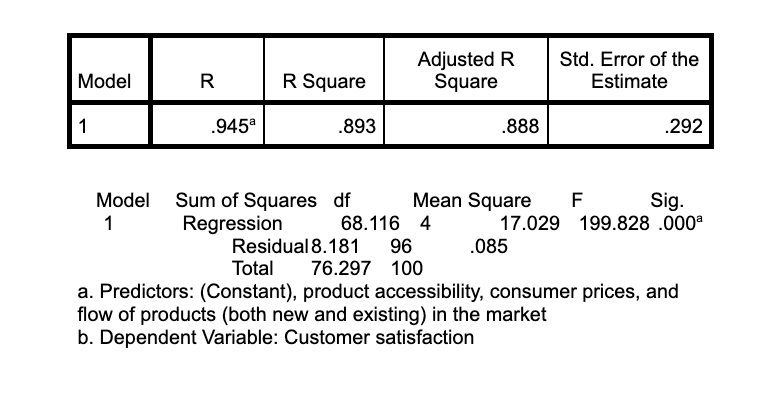
B – Adopting localized marketing strategies on global supply chains leads to higher customer satisfaction
In correspondence to the conceptual framework in this study, the relationship between localized marketing strategies on global supply chains and customer satisfaction was tested. The participant’s preference for localized marketing activities including advertising over standardized ones by multinational firms was considered as the independent variables, whereas the participants’ satisfaction with the quality and variety of products offered by the selected four brands (Pepsi, Coca-Cola, Nestle, and Almaraie) was the dependent variable. This analysis was done using Pearson’s correlation coefficient because the variables were only two. Based on the findings obtained, the R2 value of 0.910 indicated a very strong positive relationship between the variables (as shown in Table 4.3B below); hence this point is accepted. According to this point, the customization in FMCG is becoming a basic issue, but the idea lies in how the Multinational firms conduct this customization through professional instruments and strategic integration between marketing and supply chain within an effective supply chain network which requires more strategic integration with the local marketing talent.
Table 4.3B – Correlation analysis between customer preference of localized marketing activities on global supply chains and customer satisfaction
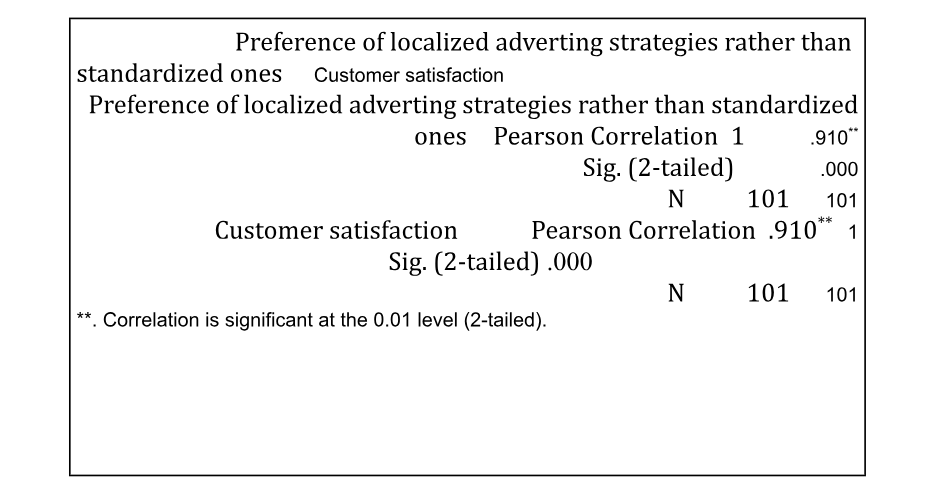
C – Integrating customers’ needs along the supply chain leads to higher customer satisfaction and loyalty intentions
Further, the relationship between integrating customer needs along the supply chain management and customer satisfaction was investigated. In this analysis, accessibility of consumer products, prices, and customer service that meet the needs of the customers were independent variables, whereas customer satisfaction was the dependent variable. The analysis was done using regression in which the R-value of 0.947 obtained indicated a very strong relationship between the two variables (as shown in Table 4.3C). On testing the level of significance, the P value of 0.000 obtained confirmed the positive relationship between the research variables; therefore the point is accepted.
Multinational firms have to come a long way as a profession by changing their focus from merely providing excellent customer service to managing relationships with target customer segments. As customer demands are becoming highly dynamic and the rapid change in the global business environment requires multinational firms to consider laggards in adopting these game-changing trends to achieve higher customer satisfaction.
Table 4.3C – Regression Analysis of Supply Chain Ability to meet Customer needs and Customer Satisfaction
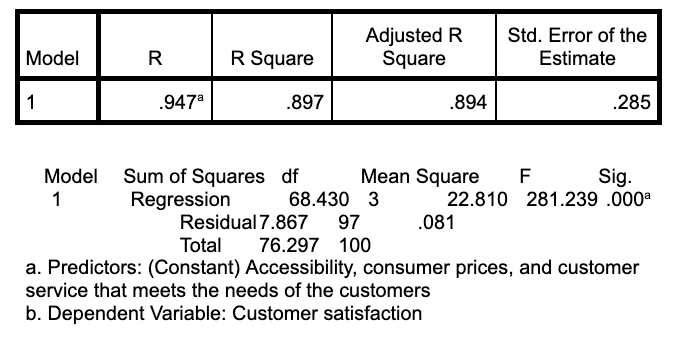
After we examined the customer’s dynamic needs, we can conclude that in FMCG the marketing activities should be adopted to meet the local customers’ needs so the supply chain management should also be adopted to meet those different needs, in turn, the integration between marketing and supply chain management should be more integrated on a strategic level that will be more clear on the following paragraphs.

Global Supply Chain With The Local Marketing Talent – part 4
This research released by Ahmed Ragaie in 2014 during his masters degree from ESE, University of Buckingham.
To get a full understanding of the research about “ Global Supply Chain with the Local Marketint Talent “, Please read the articles from part 1 to part 9.
Research Methodology
3.1 Introduction
After exploring the theoretical framework underpinning this study in previous parts, this part now presents the research methodology employed to provide answers to the research questions. First, the research design is presented, followed by the research model in which the research philosophy, approach, and data collection methods employed are discussed with justifications for each choice made. Further, the data analysis techniques employed, validity and reliability issues, and ethical considerations are presented as the chapter concludes.
3.2 Research Design
There are three main research designs as suggested by Mitchell & Jolley (2012), which include exploratory, descriptive, and casual research. Based on the nature of the research problem, this research selected a combination of Descriptive (more in-depth) and Causal (relationship between cause and effect). A descriptive research design was selected because it enables the researcher to get more insightful ideas, which have been collected (Vaus, 2001). On the other hand, casual research was considered to be suitable because it establishes the causal relationship between the research variables (Marczyk et al, 2010). In this regard combining both descriptive and causal research designs was preferred to explain in depth the relationship between the research variables which include supply chain management and marketing also evolving the integration between marketing and supply chain management on a strategic level, about the changing marketing environment characterized by rapid change of customers perception and highly dynamic consumer needs, as well as the importance of the local marketing talent in global supply chain management design and strategies for the Multinational firms.
3.3 The Research Model
(Saunders et al 2009) established a standard research model in terms of a research onion (as shown in figure 3.3 below). While some of the outer layers in the research onion may not be considered necessary, (Crowther & Lancaster 2012) suggested that the research philosophy, approach, and strategy (methods) are the most fundamental because they help in defining the nature of the research problem deeper and more explicitly.
Figure 3.3 – The Research onion
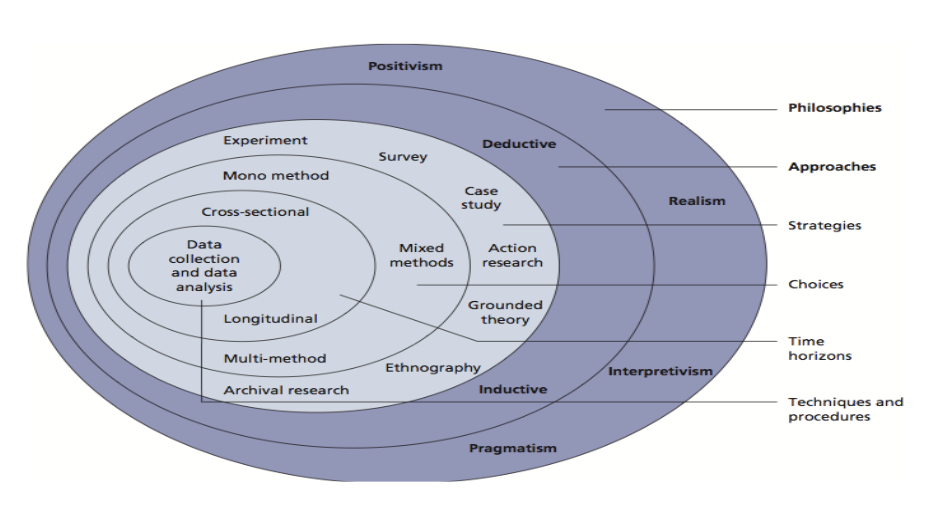
3.3.1 Research Philosophy
Deciding the nature of research philosophy is considered by (Bryman and Bell ,2007) to be fundamental because it determines the nature of knowledge to be incorporated into the study. This study is based on epistemology philosophy because the ultimate focus is to study what is acceptable knowledge in a field of study (Cooper and Schindler, 2010); and thus adopting this research philosophy enabled the researcher to study how supply chain can be linked to marketing concerning exiting concepts underpinning the research variables. Under the epistemology philosophy, a combination of positivism and interpretivism research paradigms was considered to be the most suitable for this study. This was guided by the nature of the research problem where positivism enabled the researcher to empirically the underlying relationship between the research variables (marketing and supply chain management) through scientific verifications (Lodico and Spaulding, 2010); whereas interpretivism enabled the researcher to establish social influences of how marketing and supply chain ought to be aligned with each other on a strategic level.
3.3.2 Research Approach
The two main research approaches as suggested by (Saunders et al, 2009) are deduction and induction. The induction approach involves the building of theories while deduction is used in testing theories (Wiersma, W. (2002; McBurney & White, 2009). In this study, the researcher has considered a combination of both inductive and deductive research approaches. This was guided by the nature of the research problem where achievement of the research aim necessitated testing of hypotheses based on the existing theories (using deduction); while also necessitating an in-depth examination of the research problem (using induction). This involved testing the relationship between supply chain management and marketing, while also gaining deeper insights on the role of supply chain management in marketing. This involved testing the relationship between supply chain management and marketing, while also gaining deeper insights on the role of supply chain management in marketing and the role of marketing in the supply chain as well as the role of the strategic integration between both with the importance of integrating local marketing talent into the global supply chain management design for the Multinational firms on a more strategic level. So the data and analysis section in the next chapter, which will represent the findings gained from data collection about the integration between marketing and supply chain management also represents the strategy development in supply chain management based on the recognition that diverse types of capabilities organizational process, as well as systems, needs to be taken in consideration for the Multinational firms in the formulation and implementation of their global marketing and SCM strategies ((Varadarajan, 1999), and their way of thinking when integrating marketing and supply chain management on a strategic level within the global market as we gained a valuable information from the literature review chapter it will be testing and analyzing within the finding – data and analysis chapter.
3.3.3 Data Collection Method/Strategy
With regard to the research onion established by Saunders et al (2009), there are various research strategies that researchers must choose from. In this study the researcher considered data collection from different perspectives for different authors about the relationship between marketing and supply chain management through interviews with MNC directors and employees, also using questionnaires and case analysis to develop the theory and move it into a more strategic level, to be the most suitable on this research. This was guided by the need for triangulation, which is necessary in providing comprehensive data on a research problem (Crowther & Lancaster, 2012). A survey research strategy was considered in this study because it enables the researcher to collect data from multiple participants simultaneously; thus enhancing time-saving while facilitating diversity in the research findings (Creswell, 2014). Questionnaires and case analysis were considered in this research because it enable in-depth investigation of the research problem by focusing on a few subjects within the research phenomena (Bynner & Stribley, 2010).
In this research, semi-structured interviews were conducted with supply chain management, legal and marketing department teams, sales teams, and H/R directors, and others of three multinational firms (Coca-Cola, Pepsi, and Nestle) also with Almaraie that did a joint venture with PepsiCo in Egypt to understand and realize the way marketing and supply chain management are collaboratively conducted. Semi-structured interviews were preferred in collecting data from the selected people because it enabled the researcher to get deeper insights into how global supply chains influence local marketing talent and strategies of the selected case study organizations (Simon, 2011). Almost all of the interviews were conducted using phone interviews. The marketing directors and the supply chain management directors from the three organizations were asked similar questions. The rationale of asking both the marketing directors and supply chain directors the same questions was to establish whether there is a common viewpoint and perspectives from both sides; and hence help in establishing if there is any link between supply chain management and marketing activities and the importance of local marketing talent in global supply chain management for the multinational firms. However, the legal practitioners for the companies were asked different questions. Before the actual study, the researcher had to get permission from the companies’ management bodies; and subsequently from the specific individuals being interviewed. About Almaraie Company the questions had some differences according to the joint venture with PepsiCo.
The selected case study organizations were in the fast-moving consumer goods (FMCG) industry. The researcher sees this industry as the best that can represent the research idea which is “the global supply chain with the local marketing talent”, so the marketing talent could be highly suitable for FMCG also considered this industry to be the most appropriate for investigation In Egypt because a study conducted by Oxford Business Group (2013) indicated that FMCG in Egypt industry has shown consistent growth as reinforced by the rapidly expanding middle-class population in the country. Concerning a study conducted by The Statistics Portal (2010), Pepsi is currently the market leader in the Egyptian soft drink sector (34.9%), followed by Coca-Cola Company (32%) – as shown in Figure 3.4 below.
Figure 3.4 – Market share of the soft drink companies in Egypt between 2014/2015
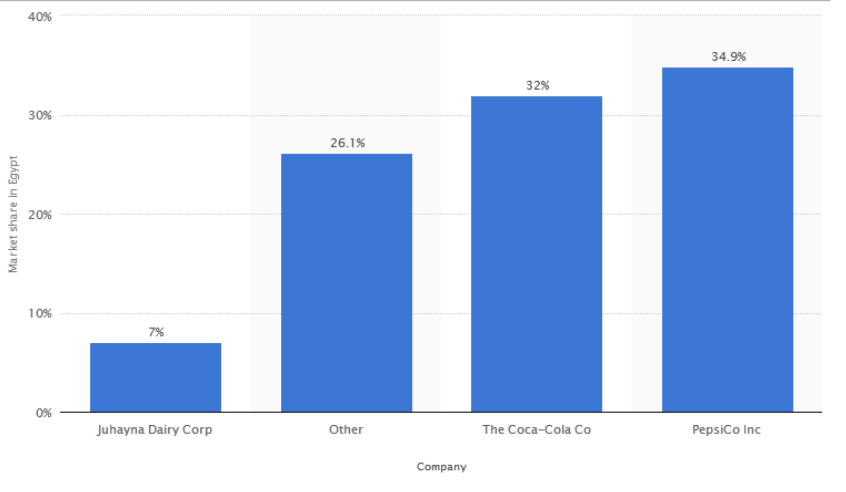
A questionnaire data collection tool was conducted on customers of FMCG in Egypt to assess and evaluate their opinions on the effectiveness of the marketing activities employed by the four case study organizations in Egypt. (Pepsi, Coca-Cola, Nestle, and Amlaraie) Systematic random sampling strategy was employed in which every 20th customer to enter in Hyper One Supermarket
chain in which the store located at Central Axis Extension – El-Shikh Zaied – Giza 1142 road in Cairo, was selected to participate. A total of 120 participants were selected in which 40 participants were selected in each store selected. Systematic random sampling method was preferred due to its usefulness in ensuring an unbiased research sample (Fisher, 2010). Since questionnaires are easy to administer, while saving the researcher a lot of time, they were also preferred because they provide the participants with ample time to respond to the questions in a relaxed environment (Gill & Johnson, 2010).
With regard to supply chain management at the Coca-Cola Company in Egypt, a study conducted by (Business Excellence, 2012) revealed that the synergy of operations along its supply chain through collaborating with all the stakeholders within its value chain is a key pillar of its success across the world. Similarly, PepsiCo’s strategic alliances with distributors across the country enable it to achieve coherence in its supply chain concerning market needs. This clearly shows that there is a direct link between supply chain activities and marketing in these organizations.
On the other hand, Nestle Egypt is currently the market leader in bottled water with a volume share of 28% (Euromonitor, 2014), while remaining third in the chocolate industry with a market share of 6.1% (Nieburg, 2014). About supply chain management at Nestle, all the operations in its highly sophisticated supply chain of the country are entirely focused on customer orientation (Nestle, 2014). In particular, the company puts the customers at the heart of everything that they do along the supply chain. From this, it is evident the importance of the integration between supply chain operations and marketing activities to enable the company to achieve a competitive advantage. Which will be clear in the data and analysis section.
3.4 Data description
Since both quantitative and qualitative data were collected in this study, a comprehensive data analysis procedure was conducted. For the data collected using interviews (qualitative), the content analysis technique was employed; due to its accuracy and effectiveness in analyzing scripts from multiple interviews (Merriam, 2009). On the other hand, qualitative data from the self-fulfilling questionnaires was analyzed using SPSS 17.0 software in which regression and correlation analysis tools were adopted.
3.5 Validity, Reliability, and Generalizability Issues
Research reliability assesses whether the research instruments can produce consistent results after multiple repetitions of the research process (Neuman, 2007). By using a systematic sampling strategy in selecting the participants, the researcher ensured that the research findings were reliable. On the other hand, validity is concerned with the ability of a research instrument to measure the true phenomena in the context of the study; and hence enhances the generalizability of the findings obtained (Wilson, 2010). In this study, the researcher ensured that the research findings were valid by incorporating triangulation in the entire research process where more than one organization was investigated while incorporating a diverse research population comprising of customers, supply chain teams, and marketing teams into the study. As a result, the researcher considers the research findings to be easily generalizable.
3.6 Ethical Considerations
Research ethics are considered (Vaus ,2001) to be fundamental for a credible research process. It is therefore necessary for researchers to adopt effective research ethics practices throughout the study. Among the key ethical issues that are necessary to be considered when involving human participation in a study include informed consent of the participants, confidentiality issues, and safety (physical, emotional, and psychological) of the participants (Bryman & Bell, 2011). In this study, the researcher ensured that the participants were informed of their rights (to withdraw from the study at any time they wish to), while informing them of the aim and objectives of the study. Further, the confidential information of the participants was not disclosed to third parties. The researcher also ensured that there were no children participants in the study. By doing so, the researcher believes that a high degree of research ethics was upheld in this study.

Global Supply Chain With The Local Marketing Talent – part 3
This research released by Ahmed Ragaie in 2014 during his masters degree from ESE, University of Buckingham.
To get a full understanding of the research about “ Global Supply Chain with the Local Marketint Talent “, Please read the articles from part 1 to part 9.
Why integration creates value
It is very important to realize that customers have at least 3 perspectives of value so when the firm’s decision makers realize and understand well all of those values they design the firm’s strategy according to meet the customer’s perspective.
We can divide the customer’s perspective of values into 3 factors:
- The traditional perspective: is an economic value that builds on an economy of scale and this economy of scale could be in operations as the source of efficiency, the economy of scale pursues to gain the benefits from fully utilizing fixed assets to attain the lowest total landed cost the main concentration of the economic value lies on the efficiency of the creativity of product/ service, and the economic value considered as the factor which seeks to doing the jobs as well as possible. And the customer always searching for products and services that are high quality at a reasonable price.
2. Market value: The customer’s takeaway in terms of market value is convenient product/service assortment and choice. Realization of economic value and market value are the criteria which very important to customers. However, firms are recognizing that’s the way to business success but also should depend on the following point.
3. Relevancy value is considered as the third perspective, relevancy value involves the customization of value-adding services or the customization of the product itself according to different locations and different customer’s appeals and demands, relevancy value means the right product /service as reflected by the market value at the right price as reflected by economic value In a consumer context for example, relevancy means transforming ingredients into ready-to-eat meals. In general merchandise retailing, relevancy means transforming products into fashionable apparel. When integrating particular components into the product to increase functionality, which is desired by customers, which results in relevancy value is achieved within the manufacturing and assembly stage. Customers need unique products & services that are addressed especially to them, and then the relevancy value is reached. To achieve economic value, market value, and relevancy, the integration of the overall business process is required, and this is known as the integrative management proposition.
More strategic integration between marketing and supply chain management,
A network business model has developed over the last 3 decades, which means the firms have moved from a hierarchal and vertically integrated shape to more closer, even virtual network of partnership with key suppliers (Christopher and Ju ̈ttner, 2000). According to this concept, the network is considered a series of nodes, which connected through links. So it’s critical and really important to manage those links through an effective integration between partners within the supply chain network to ensure the sustainability and firm’s competitive advantage. The network is viable to expand so if the network fails to act in a concert for whatever reason the potential risk for the focal firm could be in consideration (Ponomarov and Holcomb, 2009). Within the network business model the integration of the strategic decisions is something important but to integrate the network from the customer end to the supplier end is something very complicated so the strategic integration between marketing strategies and supply chain strategies is highly required. As the marketing strategies focus on the decisions associated to customer demands, market segmentation, distribution, and the marketing mix 4 p’s “product place, price, promotion” strategies (e.g. Kotler and Armstrong, 2007).
Supply chain management includes a focal firm behavioral orientation toward collaborative partners within the supply chain network as well as it also involves the process configurations across the key supply chain process (e.g. Green et al., 2006; Tokman et al., 2007). Supply chain strategies are also concerned with optimizing across organizational activities which rely on a close relationship with a high degree of interactions and integrations with marketing and sales.
The marketing strategies should be infused across organizational business processes to transform the customer perspective within the supply chain network.
On this topic, the researcher wants to mention that the interface between marketing and supply chain management results in mutual benefits to both fields through close alignment, according to this point many researchers such as (Martin and Grabc 2003) suggest that supply chain management leverage marketing strategies as well as the firm’s market orientation also it could ease and support the marketing strategy in global supply chain contexts and it has a significant positive effect on increasing customer value ( Flintand Mentzer 2004), many studies such as (Green et al,2006) suggest that firm’s supply chain strategy has a positive effect on marketing orientation such as mediate the relationship between market orientation and financial issues that lead to marketing success. A lot of studies such as (Min and mentzer 200) discussed some of the key theoretical concepts of marketing and supply chain management and concluded the following (marketing concepts, market orientation, and relationship marketing are considered factors that are inextricably linked with supply chain management. at the operational level, also the studies investigate the impact of marketing activities within the supply chain management.
The interface between marketing and supply chain management can be discussed through three different perspectives (inter-functional perspective & process perspective & integrating business concepts perspective.)
A) Inter-functional perspective:
Inter-functional perspective is considered the first contribution, which lies in the integration between marketing and logistics & manufacturing. Logistics and manufacturing are considered they have the biggest influence on the development of supply chain management, as well as seen as conceptual processors in the last three decades. Logistics is the function, responsible for managing the flow of materials & information as well as it’s contributing to supply chain management. Many researchers such as (Cooper et al., 1997) recommended and stressed the need to broaden the scope of supply chain management beyond logistics.
The interference and relation between logistics and marketing could be through the origins of logistics as the physical side of distribution as well as the coordination between both increasing the firm’s customer value creation and have a positive impact on the customer service performance.
Some researchers such as (Chen et al., 2007 and Ellinger, 2000) stressed the rapid change in the global business environment and customer demands, and here the role of local upstream marketers with the assistance of downstream marketers emerges and should be on the strategic level within the global supply chain network for the Multinational firms. The manufacturing and marketing interface has very important relationships of integration due to these rapid changes in the external business environment and customer perception & demands. The integration enables the factory to respond quickly to dynamic market changes. Many researchers such as (Kahn and Mentzer, 1998, and O-Leary-Keller and Flores, 2002). Confirm the importance of collaboration and integration between both as well as the joint decision-making on a range of performance toward customer’s value propositions.
By the way, most of the studies about the inter-functional perspective are based on the resources dependence theory that existed in 1978 (Pfeffer and Salancik) also Anderson and Salancik 1982) which has developed until now as the fundamental changes in the economic system as well as the continuous change of the global business environment and customer perception & demands. By the way, both theories (Pfeffer and Salancik 1979 and Anderson and Salancik 1982) emphasize the specialization of functional areas within organizations and the interdependence between them. However logistics & manufacturing are considered the key functions within supply chain management but they are not sufficient to reflect adequately the breadth of the conceptual domain as well as its cross-organizational nature, they just reflect a subset of the relation and interface spectrum between both disciplines. So it should be related and integrated to the other factors within the supply chain network.
B) Process perspective
The inter-functional perspective often conceptualizes the interplay from an interdepartmental stance as well as focuses on the relationships between the organizational units. But the process perspective is independent of the structure of the organization when we look at business activities that are traditionally related to marketing and supply chain management, also the process perspective is expanded to involve suppliers & customers within the supply chain
The process integration within and between organizations or partners in the supply chain is a key characteristic of the conceptual domain. By the way according to the marketing point of view which sees the operation is an element that increases customer value marketing is embedded in the way that customer value is maximized, because of their cross-functional nature process which facilitates the interpretation of the relation and integration between demand creation which marketing is embedded and demand fulfillment process as the supply chain management process (Christopher and Payne, 2002, Ju ̈ttner et al., 2006). From this point, we can say that the integration between demand creation and fulfillment processes is considered the key to delivering products that transform value to the customers through efficiently deploying resources. (Srivastava et al., 1999). Said that the exploration of the interdependence among the processes should lead to high success in the marketplace rather than concentration on improving the individual processes. ( Rainbird 2004) provides a processes fusion model that focuses on the integration between demand and supply chain processes, “Rainbird” differentiates 8 supply processes which start from order receipt/entry until delivery option and he introduces 7 demand processes such as customer relationship management and one of the essential processes is macro market definition. “Rainbird” mentioned the following “The linkage or the fusion between those processes can be achieved among 2 factors management, specific organizational capabilities or technology. From this point (Ju ttner et al. 2007) built his vision and suggested three layers of processes integration model that links between demand which marketing is embedded, and supply chain process to the customer’s buying life cycle that’s related to customer value propositions through adopting the expanded supply chain perspective and linking marketing & supply chain processes to customer value creation, from this point the process perspective captures a wider range of the interface spectrum between marketing and supply chain management rather than the inter-functional perspective.
C) Integrated business concepts perspective:
In the last decade, diverse business concepts have emerged associated with ideas that focus on the integration perspective between marketing and supply chain management, such as “QR” quick response, agile supply chain management, as well as the last one that was introduced recently “DCM” demand chain management approach. All these three concepts seek to bridge the gap between the supply chain management and the market by increasing the supply chain’s response time, flexibility, or its differentiated customer focus which confirms the purpose of SCM toward customer value creation.
First lets explain
1) The concept of QR movement began in the North American textile and apparel industries and was introduced to the market as a competitive response to low-cost competition from offshore manufacturers, the description of “QR” (Christopher and Towill, 2002, p. 2). Can be described as the following; it’s a model of time compression that aims to reduce the time in the supply chain management that builds on the recognition which closer to the customer means creating value for the customers. Closer refers to closer on time more than closer in distance, The QR concept was the first concept that exploited bi-directional feedback and feedback forward flows of information between the expanded supply chain, among fast exchanges of demand information between not only apparel& retailers manufacturers but it was also textile industry producers. QR concept identifies that demand-driven decisions could be made at the last possible moment, and this guarantees the maintenance of diversity offerings while also enabling the firm to decrease the lead time cost and inventory.
2) Agile supply chain management: The origins of agile supply chain according to the business concepts can be described as the flexibility system of manufacturing, but flexibility as its key characteristic was soon expanded to the supply chain level as (Naylor et al 1999) mentioned. The main objective of agility lies in using market knowledge and virtual corporations to exploit profitable opportunities in a changeful marketplace.
Some researchers such as (Christopher 2000) focus on and stress the ideas of the process–driven and network–based as two further distinguishing elements of agile supply Chains., Agile supply chain management is viewed as a proper approach in contexts with the important need for quick reaction to the violate changes in the market demand, either in volume, variety, marketing mix, by the way, and according to (Goldman et al 1995) who said that this helps the firm to exploit the unpredictable changing customer opportunities.
3) DCM concept: this concept is considered the most recently introduced approach and it is still being developed now, as well as it lacks a consensus on its characteristic definition. Some of its supporters such as (Selen and Soliman 2002) define it as a factor that has a set of activities that aim to manage and coordinate the whole supply chain starting from the end customer as well as working backward to the raw material supplier. However other researchers who criticized this concept see this concept, as’s broad understanding and also mentioned that this concept would imply that, the demand chain term could effectively replace the supply chain. Instead, they recommend restrictions of the concept to demand chains for products with innovative demand, where supply chain efficiency is a trade-off for customer service (De Traville et al.2004). In any case, the DCM concept focuses on linking supply chain management to market characteristics and this perspective came from the idea that explained that customers are becoming increasingly sophisticated and demanding.
Hence the importance of integrating local marketing talent into the global supply chain management design for multinational firms on a more strategic level.
All three concepts emphasize the behavioral orientation within the supply chain toward the customers such as the supply chain should be designed and operated from the customer backward rather than the factory outwards.

Global Supply Chain With The Local Marketing Talent – part 2
This research released by Ahmed Ragaie in 2014 during his masters degree from ESE, University of Buckingham.
To get a full understanding of the research about “ Global Supply Chain with the Local Marketint Talent “, Please read the articles from part 1 to part 9.
Research Topic
Global Supply Chain With The Local Marketing Talent
Released in August 2014
Economic of scale and economic of scope
Now we’re moving to describe the economies of scale and economies of scope and its relation with marketing and supply chain management
First, let’s define the economies of scale and economies of scope
Economies of scale
Economies of scale refers to the accumulated volume in production and sales which occurs by decreasing the cost price per unit due to the experience curve and increased efficiency in a lot of factors such as production, marketing, and other factors. The global presence has a significant effect on extending the firm’s scale of operations by giving the firm a large capacity in its production as well as a large asset base. From this point we can say that; through large scale, the firm could create a competitive advantage but in case if the firm converts the scale into economies of scale, to make the idea more clear we can describe some benefits from economies of scale according to (Gupta and Govindarajan, 2001):
- Decreasing the operating cost per unit as well as spreading the fixed costs over a larger volume due to experience curve effect
- Pooling global purchasing supports the firm and provides an opportunity to concentrate global purchasing power over suppliers which leads to volume discounts and reduces the transaction cost
- Increase the talent of the members within the firm
From this point we’ll move to the other side, Economies of scope to explain more the idea of the relation between economies of scale and scope to marketing and supply chain management.
Economies of scope
First, let’s say the economies of scope happen when the firm is serving in diverse marketplaces in the world, simply the global scope can’t take place in case the firm is serving customers in just one country, customers should purchase a bunch of identical products and services across diverse countries and they can bring those products either from a horde of global suppliers or a single global supplier (international marketer) that are presents in all of the markets which the firm is already serving customers within. From this point, we can conclude that compared with a horde of local suppliers and a single global supplier (marketer) can lead to an increase in the value for the global customer among the consistency in the product’s quality and features as well as in the services across countries, here we can conclude the importance of the integration between marketing and supply chain management within professional supply chain network across the countries. As well as the importance of local marketing talents will be clear in the following paragraphs.
The challenge in capturing the economies of scope within the global level lies in the quick response from the firm on the tension between two factors: The need for central coordination of most elements of the marketing mix and the need for local autonomy in the actual delivery of products and services ((Gupta and Govindarajan, 2001). As the adaptation approach is Highly required in today’s business; multinational firms are serving a lot of different customers in different countries across the world. Could gain benefits from the concept of economies of scale and scope through transferring the experience gained from one country to another country in terms of similarity in culture, customer characteristics, and business environment. From this point, we can conclude that if the firm is concerned with improving the local marketing talent in different nations, it can exploit the experience that the marketer gained and use it in another country that shares similar culture, customer characteristics, and business environment. Which will be represented in the data and analysis section.
From the paragraph above we can conclude that everyone in the supply chain may value something different within the global value chain.
The value chain as a framework for identifying international competitive advantage
In all stages in the value chain, there’s an opportunity for a positive contribution to the firm’s competitive strategy through performing some of the activities or processes in a way that brings a competitive advantage in comparison with other competitors and if the firm can attain such a competitive advantage that’s profitable, defensible, and valued among the market, so it can earn high rates of returns.
In competitive terms, value can be defined as the amount that the buyers are willing to pay for the products or services that the firm provides to them, “perceived value” when the value of the products or services that the firm provides to the customers exceeds the costs of doing them, then the firm is profitable. And this is the goal of any generic strategy.
The value chain displays total value and it consists of value activities and margins.
The value activities can be described as the physical and technologically distinct activities the firms perform, as well as it’s the building blocks by which a firm creates a product or service valuable to the buyers Margin can be described as the difference between the total value (price) and the total and collective costs of performing the value activities.
Value chain activities can be defined as the key that links the company resources and its strategic position within the global market. And on this point, one logical question emerges here that’s; when the company resources considered to be valuable?
The answer is, that the company resources could be valuable when they are transformed into activities that generate either lower cost or greater value than competitors ( Sheehan and Foss,2009)
The firm might be able to identify elements of the value chain that aren’t worth the costs and this could be conducted outside the firm called “outsourcing” hence the role of supply chain management emerges.
The value activities are divided into 2 types:
1- Primary activities are the activities involved in the physical creation of the product, as well as its sale and transfer to the buyer as well as the services after sales that can be technical assistance.
2- Support activities can be defined as the activities that support the primary activities and each other through providing purchased inputs, technology, and human resources as well as various and wider functions, the procurement, technology development, and human resources management are related and associated with specific primary activities and supporting the entire chain.
So we can conclude that the value chain can be described as it’s not a collection of independent activities but it’s a system of integrated and interdependent activities either within one organization or within various organizations.
“Figure shows the value chain as a framework for identifying international competitive advantage

Global Supply Chain
When defining supply chain management, Most of the authors focus on the importance of the various chain players also consider the customers as vital players in the chain and this supports the research idea of “the importance of the local marketing talent in global supply chain design” about understanding and realizing the customer’s psychology wants, needs, characteristics, and behaviors are essential and the researcher consider this point as the main point in the organization success in all domains, so the researcher opinion is that; the best persons who can realize this point is the local marketer so the global supply chain as it essential in reducing cost and the success of the multinational firms in different markets should be according to the local marketing talents lets see how different authors talk about the supply chain management
A lot of definitions of supply chain management focus on the 2-way flows of goods and services along with information & funds from the purchaser to the user.
One of the interesting detentions that also support the researcher’s idea is the following:
Monczka et al. (2002) indicate that changes in global business conditions and situations as well as the competition increases among organizations have influenced the management complexity of all organizations.
In today’s business conditions, all organizations should manage both the upstream firms—suppliers that provide direct & indirect inputs and the downstream firms- distributive network.
Also, the author said; that the supply chain includes all the activities that are related to the flow and transformation of goods that start from the raw materials until the end user. The supply chain includes the managerial system, production & production scheduling, operation & assembly, inventory management, warehousing, transportation, and customer service. Supply chains are essentially linked to suppliers and customers; we can consider every customer is in turn a supplier to the next downstream organization until the final product reaches the ultimate end user. Supply chain management is considered the integration of all those activities through improving the supply chain relationship to attain a sustainable competitive advantage.
The points that are very interesting to the dissertation’s main idea . Supply chain management includes the associated information flows, materials & information flow up and down the supply chain, the author focuses on this point but as the information came from the upstream marketer from the Head Quarter the dissertation point view according to the researcher perspective, that the information should come from the Upstream marketer with the assistance from the downstream marketer from the local market and sure it should be aligned with the headquarter and the reasons will take a critical discussion in the following paragraphs supported with real examples.
Supply chain management has a tremendous impact on the strategies of any organization, mainly those associated with purchasing and sourcing, also it contributes to multiple organizations as chain participants.
Supply chain management can be divided into 3 parts :
- . Internal functions
- . Upstream suppliers
- . Downstream customers
1) The internal functions: the internal functions of the organization have some duties such as order processing that include extensive customer interaction that starts from taking the order until aftermarket service. One of the other duties of the internal functions within any organization is production scheduling which includes actual plans and schedules.
2) The upstream suppliers: the main function of the upstream suppliers is to manage the flow of the right materials at the right time to the right internal users.
3) Downstream customers; the main functions of downstream customers include the distribution channels, the process and function which the products possess through To reach the ultimate customers. In this area, the logistics managers are involved in managing transportation and distribution.
“Monczka” observed that there are upward and downward flows of both the materials and the information as well as the funds between the players or the participants of the supply chain management, its very important and also considered imperative to manage the relationship among those participants to align the activities between all of them. Effective management of the Supply chain is considered the core competency that offers an opportunity for competitive advantage to the organization in domestic and global markets as well it presents the following:
- Cost reduction
- Improving the delivery of the materials
- Shorter cycle time including product development cycle time
- Quality improvement. Access to a product and process technology
Ross said the supply chain management is based on 3 dynamics:
1- Operation management techniques
This refers to all the organization’s functions such as manufacturing, marketing, and finance. Those activities should be integrated to form the common business system and these techniques offer comparative advantage through adding value to the daily work and day-to-day performance of the regular activities. The 3 sets of activities are the inbound logistics, processing activities, and support activities.
2- Integrated logistics management
The main objective at this level is to interface closely with each other but not merge the identical functions performed by logistics counterparts outside the supply channel partners and this point takes us to one of this research ideas “In which degree the interdependent/integrated global economic system are driving the Multinational firms to rely on a network of relationships with external organization or parties.”
The main rationale of the dynamic process is that an organization needs support not only from its internal supply chain partners but also from external supply chain partners to gain a global competitive advantage and market leadership to manage the supply chain management toward customer value creation. Also, this point will be clear in one of the case studies of PepsiCo which did a joint venture with one Arabian company Almaraie.
3- Strategic dynamics
This part concentrates on reducing costs and time and also focusing on adopting the management technique as well as the management information system to attain breakthroughs in products and services that are suitable for the change of the customer needs. This strategic dynamic focuses on and opens up new dimensions for the firms as well and it enables the firms to attain a competitive edge between setting alliances with channel system partners as well as offering relationships, which are based on marketing to suppliers and customers.
After the analysis above Ross summed the definition of supply chain management as the following:
Supply chain management is a continuously evolving management philosophy, which is seeking to unite and consolidate the collective productive competencies and resources of the business functions that are within the organization and outside the organization. Supply chain management always searching for innovative solutions and synchronizing the flow of materials and information to create a unique source of customer value.
The ultimate objective of supply chain management is to achieve a strategic fit between the organization competitive strategy and supply chain strategy, the treatment that can achieve this strategic fit effectively is to understand and realize very well the customer demand that can help the organization to manage well the production and services as well as to define the cost and services requirements and understanding the supply chain activities that should drive according to the customer value creation, according to the multinational firms that doing business in different countries that have different customers, so the researcher sees that the local marketing talent should take high consideration on designing the global supply chain strategy, which means to be integrating with the global supply chain management design for the Multinational firms on a strategic level not only on operational and tactics level.
The major question here is if any mismatches exist between the capabilities of the supply chain of doing with considering the local customer demands and appeal, what the multinational firm should do?
- Alter its strategies in the local market that’s means the branch of the firm or the subsidiary should adopt their strategies and activities to be matching with the global supply chain of the multinational firm however this strategy doesn’t suit the local responsiveness to a high degree
- Alter the structure of the supply chain design to be able to satisfy the local customers for each different market and in this point, the role of the local Upstream marketer with the assistance of the downstream marketer should emerge and engage in the supply chain structure and design into more strategic level.
So the answer is the firm should alter the supply-chain design.
Another important element for this question, do the multinational firms set its marketing strategies according to the capability of the global supply chain or set the structure of the supply chain design according to the local market demands that’s means not suffice to depend only on the local market responsiveness and then either continue on this scale and design or alter and redesign the supply chain so from this point the importance of integration between the marketing and manufacturing & logistics, enable the factory to have a quick reaction as well as respond quickly to the dynamic market changes also ensuring the value creation for the customers, from this point the question here what about to make the factory have more quick reaction or could be parallel with the customer demands and trends changes in different market across the world so the dissertation is mainly focusing on the importance of global supply chain with the local marketing talent that should be integrated on the strategic decisions in the global supply chain design for the multinational firms on more strategic level.
Fredendall and Hill (2001) and Burt et al. (2003). Fredendall and Hill (2001) focused a lot on this point and examined the importance of including customers as one of the participants on the supply chain management and with the multinational firms this mainly depends on the local customer responsiveness in each different market.
Ross (1998) also highlighted the importance of customers and he mentioned that supply chain management should be completely customer-driven. Supply chain management plays a vital role in the communications of customer demand from the point of sale back to the supplier as well as the physical flow process that ensures the efficiency of cost and time, this is very important to ensure the efficiency and effectiveness of the application of supply chain management, Ross mentioned that the products should be customized because of customers nowadays are increasingly accustomed and this requires to receiving customized products and services specially as the market responds to demand-pull product strategies rather than push product strategies and for multinational firms, the responsibility of the local upstream and downstream marketer plays a vital role on this issue.
Various paradigms of supply chain management focus on the management of internal customers as well as external customers. The definition of internal customers can be as follows: internal customers can be defined as the receiver persons or could be a department of another person’s or department’s output or final product, service, or information. Many researchers and dictionaries like (APICS Dictionary, cited in Fredendall and Hill 2001). Also defined the internal customers as the persons or departments that ensure the delivery of products and services as well as the information to the external end-users.
According to Ross (1998), he mentioned that supply chain management is a dynamic and open–ended approach to marketplace competitiveness, and also it can be a continuous process of determining intercompany performance, product& services quality, information system techniques as well as the organizational & personal competencies to utilize the different customer demand, by the way, the utilization of both internal and external participants help the firms to achieve productivity profit and growth and can be done through the 2-way flows of product & service in information & funds from raw material until the end-user.
(Burt et al. 2003) defined supply chain management in very simple words” linkage between the ultimate customers and mother Earth”
Burt highlighted the involvement of funds and described it as the funds that come only when end-users purchase products or services, otherwise, the transactions that are performed within the supply chain could be as the simple allocation of those funds through the chain’s internal & external members.
A very important factor emerges on this point: professional communications and information flow tools are very important and valuable factors to coordinate and synchronizing the activities that are performed between the members within the supply chain management.
Here the importance of the strategic integration of local marketing talent in the various markets for multinational firms.
Collaboration
Collaboration can be defined as the process that involves the adaptation of a high level of purposeful cooperation of each partner to attain a trading relationship over time which is bilateral which means the partners have the power to shape the nature of the future direction over time. The mutual commitment of partners to the future is something essential in collaboration as well as the power relationship balance plays a vital role in collaboration.
The collaboration could have some disputes between partners so managing those disputes is critical the supply chain management should design the duties and function between partners as it is essential to success so the strategic integration between marketing and SCM as well as the local marketing talent is very important to the multinational firms.
Four important characteristics define the firms that succeed in developing global supply chain networks to control and manage the total supply chain costs and enhance the quality
1) Corporate Global vision:
The primary question on this point lies in “Do multinational firms create an effective global vision which is the primary driver for investing resources and effort in seeking global suppliers and customers?
On this point, if there’s no ideal vision of what the firm is focusing on and trying to achieve in their global marketing strategy and this vision should be well understood to all the firm’s subsidiaries in different markets will result that the managers in all subsidiaries will get confused in doing their activities.
Coordinating business unit strategies between all the firm’s subsidiaries is very complex so what about coordinating the business unit strategies with the external suppliers, as the multinational firms are seeking to expand their global operations as the effective vision as a primary force for developing a global supply base, so this take us to the idea of the multinational firms should integrate their local branches or subsidiaries in different markets in the strategic decisions and make them deiced what are the strategic business unit that should be conducted in their local markets and for sure under the headquarter consultancy otherwise the multinational firm should deploy a lot of headquarters which can identify the firm strategic decisions and strategic activities and this also require high costs and high tanning as well as the employee in different headquarter should be well understood and realize the local culture and business environment and people demographics of the country that doing business within but on a practical way not suffice to study reports through internet or reports from the managers from the different branches of the firms because as the research mentioned; the best persons that can realize well the people demographics and culture of the local market are the persons who are living in the local market.
2) Management structure and systems
The question on this point lies on: Are the multinational firms organized to promote an effective way the coordination through different global strategic business units?
Successful multinational firms have invested a lot of money and efforts in order to enabling the firms structure system to deploy the firm’s global vision through different ways and actions such as Global community council and reporting systems in order to deploy and ease the communications among different subsidiaries in different countries, also the international procurement officers (IPO) and sales officers should be in contact and make a strong relationships with governmental agencies to promoting its global strategy as well as to gain effective experience and knowledge regarding the traditional sourcing as well as the sales opportunities and country regulations and procedures as well as the multinational firms can gain an opportunity to improve total cost models for decisions making and one of the main important benefits is that the multinational firms can gain a valuable information regarding to providing sourcing and demand information to global production design sites so including the local marketer in those operations can facilitate performing all of those activities also the main important that the local marketer should be involved in determining the supply chain design and the multinational firm’s headquarter should adopt its global supply chain according to the local marketer recommendations.
3) Configuring the global supply base
The question on this point lies in “Are sourcing and sales strategies developed to optimize the mix of global suppliers/ distributors and local suppliers/distributors when the multinational firm sets up production units in a new country or region?
Almost of successful multinational firms often have discovered and the researcher used the word “has discovered” because, in global marketing strategies, there’s nothing fixed but rapid change always exists and is considered one of the main challenges of multinational firms, so discovering and investigating the concepts and the nature of the global business and environment is variable, for any case they have discovered that some mix of global and local suppliers/distributors is the optimal however the mix may occur some changes in their multinational firm’s supply chain but the benefits are greater than a change in some of the multinational firm’s supply chain strategy especially they can gain a valuable experience from the local suppliers. So the local marketer plays a vital role on this point.
4) Supplier development
The question on this point lies in “How could the multinational firms treat their global strategy to reduce costs among different markets and how it can ensure the supplier’s capabilities in the competitive & manufacturing strategies and align all the activities?
Supplier development approaches are different from one country to another or region to another according to the specific sort of problem encountered, Developing a global supply chain strategy requires a fundamental shift in the way of thinking in doing business, one of the main drivers on the marketing decisions is to understand well the total cost of the ownership across the entire global supply chain through understanding and realizing the cost drivers among well understanding and realizing the drivers of cost that underlie total cost, managers will have the availability to implement a strategic design to reducing cost.
From the four characteristics above we can conclude that the world economy is becoming integrated and interdepend which is driven by global market forces, as well as global cost forces and technological forces should be one of the highest priorities as the political and macroeconomic forces all of those changes affect the way of multinational firms think on doing business globally so the integrating marketing and global supply chain with local marketing talent is very important. Also, supply chain management usually involves a plethora of countries, as it comes with a plethora of new difficulties, to manage the global supply chain well, you have to think well about reducing costs and one of the main important factors in reducing costs is local labors.

Global Supply Chain With The Local Marketing Talent – part 1
This research released by Ahmed Ragaie in 2014 during his masters degree from ESE, University of Buckingham.
To get a full understanding of the research about “ Global Supply Chain with the Local Marketint Talent “, Please read the articles from part 1 to part 9.
Research Topic
Global Supply Chain With The Local Marketing Talent
Research Questions:
- What is the importance of local marketing talent within the global supply chain network for multinational firms?
- What kind of supply chain relationships best facilitate the integration of marketing strategy planning and execution?
- Can we extend organization learning to supply chain learning?
- Can we extend market orientation to supply chain orientation?
- What are the best methods for capturing the voice of the customer in different firms embedded in different national and corporate cultures?
- How should globally derived voice of the customer data be integrated and contemplated within strategic market planning?
- What roles do qualitative and quantitative customer data play in customer value prediction at various points in global supply chains?
- Should customer value learning and creation processes be formalized and standardized for maximum global supply chain effectiveness and efficiency or is the world so hyper-competitive and amorphous to require more temporary, localized, ad hoc processes?
Research Objectives:
1- Re-evaluating the relationship between marketing and strategic supply chain management and transferring it to a more strategic level, in addition to providing a new framework and ideas for this relationship and new strategies that must be innovative by the rapid change and quality management system in the global business environment and customer perception. orders across different markets around the world.
2- Integrating local marketing talents with global strategic supply chain management design for multinational companies.
Keywords
Global supply chain, strategic integration between marketing and SCM
Global Value Chain, Collaboration, Standardization vs. adaptation Local marketing talent, Economies of scale & Economies of scope
Framework

LPG and Global Supply Chain
Liberalization, Privatization, and Globalization (LPG) economic systems have a significant effect on the competitiveness among firms, as many factors lead to an increase in the interdependent & integrated economic system called the global economic system, as a result, the competitive environment faced by the firms has a dramatic change since the last decade as a result from the drivers of globalization like decreasing tariffs and barriers and improving transportation and information technology as well as we live on the era of the communications activities.
These changes gave the firms high access to produce globally and the result from this was a proliferation of choices for consumers all over the world this required the firms to offer greater products and services at lower cost and high quality to remain a competitive advantage and customer’s satisfaction and increasing their customer value creation and relationships, so this pressure lead to more emphasize on reengineering internal business process as well as working more collaboratively with customers and suppliers to integrate planning and operations throughout the supply chain management.
The changes also have a significant effect on increasing the dynamic markets and lead to more uncertainty about customer demand, day after day customers gain more access to more products and services globally as well the introduction of new products and services is occurring at a faster pace.
The main important point from the introduction above lies on; in today’s business the firm’s competitive positions mainly depend on the ability to realize and well understand the changes of the customer demands and perceptions which have a rapid change also the differences of customer tastes and preferences among different markets to respond appropriately and quickly to those different and changeable demands for the customers.
Supply chain management tools and techniques are considered as the mechanism that allows the firms to respond to all of these changes, so strategic integration between marketing and supply chain management is an essential topic in today’s business.
Brief history of supply chain management:
Logistics activities have existed since the early 1900s and were related with the military as an essential branch of war that pertains to the movement and supply of armies. The logistics model is essential by the Military Forces which use the logistics model to ensure the availability of the required materials at the right and accurate place at the right and accurate time the logistics model is still essential and being used by the military forces until now. Since 1950 The Supply chain has been something very interesting and got more attention in the manufacturing and production sector, we can observe that the inventory became the responsibility of the marketing and accounting as well as the production areas, also order processing as part of sales and accounting duties
The supply chain is one of the most powerful engines in business transformation, The supply chain is considered one area where the efficiency and effectiveness of the operational activities can be reached it decreases the organization’s costs and improves customer service as well as increases the firm’s value chain. As much as the technological and telecommunications tools increased supply chain management became more powerful.
In the early days, the supply chain was referred to as the functions of logistics, transportation, purchasing, and supplies.
The evolution of the supply chain has moved to focus on integration, visibility, cycle time reduction, and streamlined channels. Also integration with marketing, this integration has a variety of activities that include:
- Integrated Purchasing Strategy
- Supplier Integration
- Supply Base Management
- Supply Chain Management
Competitiveness and Supply Chain Strategies
During the last decades, multinational firms succeeded by how they could capture the economies of scale and & economies of scope as well as the usage of advanced technology in their products and services into the physical assets, and this for sure increases the customer’s value creation. Competing in the global market requires new capabilities within the firm Such as considering the customers as strategic assets.
This research focuses on the FMCG multinational firms, and it’ll propose a framework to move the integration between marketing and supply chain management to a more strategic level through the integration of local marketing talent with the global supply chain management design for the Multinational firms into a more strategic level, not only on the operational and tactics level.
The proposed framework builds on these perspectives, which captures the integration between marketing and supply chain into the business unit and moves them onto a more strategic level. Integrating marketing and supply chain strategies involves the management of the following levels of integration:
- Strategic corporate, customer, and shareholder integration.
- Strategic supplier integration.
- Strategic marketing and SCM with the local marketing talent integration.
I’m focusing on explaining the customer’s value within the supply chain network, and customer segments, realizing the rapid change of the global business environment and customer demands & perceptions, and delivering value to the customers.
The purpose of this research is to evaluate and review supply chain management and its relation with marketing, to contribute to the body of knowledge by developing a conceptual framework for integrating marketing and supply chain management on a more strategic level to include local marketing talent, As well as to understand, evaluate and analyze the global supply chain and global marketing strategies, the relation between both as well as the important of integration of local marketing talent in the strategic decisions in global supply chain management to MNC also suggest strategies and activities to MNC to improve the marketing talent. and all of the above considered as the answer of why this topic is important.
Global SCM and Marketing Strategies
The value of the research could be as follows: the relation between marketing and supply chain management as it is considered an essential topic of global marketing. This research will focus on the integration between marketing and supply chain management on a strategic level as well as the importance of the local marketing talent in the global supply chain design.
This research will explain the Decision framework for the development and implementation of global SCM and marketing strategies and programs, also evaluate management decisions connected with the global SCM and marketing process, design the global SCM and marketing programs and implement, coordinate the global SCM and marketing programs within supply chain network.
The definition of global marketing to realize what are the aspects, that are essential in this study and connect it to the marketing strategy and programs within the supply chain network, to understand and realize the background and the main dimensions to be connected on the integration between marketing and supply chain management including the local marketing talent on a strategic level. So first the research will explain the meaning of local marketing talent.
Local marketing talent
To realize the meaning of local marketing talent we have to get the meaning of the following:
Talent management
Talent management refers to the firm’s anticipation and expectation of required human capital as well as the planning to meet those needs.
Talent management can be described, as the science of using strategic human resources to improve the business value for enabling the firm to achieve its strategic goals and increase its competitive advantage. Also talent management including recurring, retaining, rewarding, developing, and enabling the employee performing forms a part of talent management as well as planning the workforce on a strategic level, basically the talent management strategy has to be linked to the business strategy to make sense, and logically supply chain management is the core of the business strategy. This research focuses on the strategic integration between marketing and supply chain management so we have to realize the meaning of Marketing Talent
Marketing talents concentrate on everything related to the market and competition with customer value creation involving the value of talent that enables the firm to cover the benefits of economical areas, customer satisfaction, competitors, quality productivity, cycle time, market capitalization as well as costs and revenues, rationally those activities can’t be achieved through machines, so it should be achieved through talented persons, so the firm’s process which improves the management and marketing talent not only including hiring the most qualified and valuable employee but focusing on how to retain them and the main important to improve their skills and knowledge.
From a talent management point of view, the firm is concerned with two major areas (performance and potential), performance involves the current performance of the employee, and potential involves the potential outcomes and benefits from the talented employee so I see that the talented marketers can play a vital role if we want to move the integration between marketing and supply chain management into more strategic level that will be clear within the body of the research.
Global Market Entries
Global marketing refers to the firm’s commitment to coordinate its marketing activities across national boundaries to satisfy the global customer wants & needs better than the competition and this implies that the firm can:
- Develop its marketing strategies and activities based on the similarities and differences between markets
- Utilize and exploit the knowledge from the headquarters (home org.) through worldwide diffusion and adaption
- Transfer the experience, knowledge, and best practices from any of its markets and use it in other markets which doing business.
Hence we can conclude that the collaboration and integration between marketing and supply chain management is essential on a strategic level.
Global+local=Glocal “Think Globally, act local”
Glocalization :
Because this research focuses on the relationship between marketing and supply chain management as well as the integration between supply chain management and local marketing talent, so we have to take a look at the concept of Glocalization
Glocalization can be described as the global marketing strategy that seeks to achieve the slogan Think Global, Act Locally, which called Glocalization, which could be achieved through dynamic interdependence between the firm’s headquarters and its subsidiaries among coordination of their efforts and functions to ensure the global integration and local flexibility at most cost-effectiveness. Principally the value chain functions should be carried out which is not required to be achieved only from the firm’s headquarters (Bellin and Pham, 2007) so the role of supply chain management and marketing is critically important in this topic.
The key point of Glocalization is knowledge management which refers to continued learning from experience, from this point I want to mention that in the context of global marketing, the management of knowledge can be achieved through cross-culture activity, which its key task, is to foster and continually upgrade collaborative cross-culture learning. Glocalizaton is one part, which is also important for the research’s main idea.
Organization’s Marketing Structure
* Centralization vs. decentralization
One of the core activities of any multinational firm lies in the organization’s marketing structure, which could be centralized or decentralized. One of the main functions of the firm’s marketing activities is communication. The marketing department continuously tries to communicate the brand image, mission, and objectives as well as the products & services of the organization. And how the communication approach might produce different marketing tones, which is affected by the firm’s structure and how the different departments are allocated. For example in a centralized marketing approach, there is only one marketing department that controls all the marketing activities from the headquarters in the home country that responsible for managing and conducting all the different marketing initiatives and unifying the brand image this approach is applied when the Multinational firms conducting global standardized marketing strategy.
Decentralization basic view refers to that multiple business groups can make a decision. Some benefits from decentralization are adopting the products or approaches to the local culture insight, local competition, local language & laws, and increasing the sales channels. And this point is considered as one of the reasons, that increases the importance of integration between marketing, and supply chain management.
Usually, the decision to centralize or decentralize the organization’s marketing activities comes by default, based on how the company is structured as well as the relation between marketing and supply chain management plus the capabilities of the supply chain to meet the different customers demands in different markets which considered as one of the main Important factors which are essential in the organization’s decision of centralized or decentralized, and this factor considered as the nature of the product or services that offered.
The research focuses on “FMCG “fast-moving consumer goods and this industry always depends on decentralized as well as adaptation approaches in their marketing strategies and activities, also the research will examine the mix of both centralized/decentralized with its relation within supply chain management and the importance of integration between marketing and supply chain management on diverse perspectives.
The mistake often lies in lumping everything under marketing because it should be under the supply chain management with its relation to marketing.
The level of benefit will depend on what part of the marketing function we talk about as well as the level of scale benefits that could be achieved within the supply chain network also the factors that affect the advertising have a critical interest as well as the market segmentation variables have a significant effect on the advertising process in different ways.
The contextual variables include regulations and media availability as well as the costs of advertising plus the number of competitors in the foreign market.
Multinational firms should take into consideration the local advertising regulations which means some global ideas can violate the rules and regulations in one particular market, so multinational firms should realize the essence of globalization of advertising while considering local responsiveness which means the adaptation should be conducted (think globally, act locally) when dealing with different cultures, the Multinational firms should realize how this different cultures decoding the advertising so the decentralized approach should take place on this area of working.

Organization’s Marketing Structure
The standardization vs. adaptation
One of the most important decisions associated with the marketing mix is developing an adequate marketing mix in diverse markets to achieve the firm’s objectives. The products that entire new markets for the first time should be adopted and tailored to the characteristics of the customers to be suitable to their demand, especially taking into consideration the existing heterogeneity of the markets ( Vignali,2001). In this point, we can say that the decisions of standardization or adaptation make a lot of organizations redesign their supply chain management with its relation to marketing activities and should manage well the supply chain network.
The global strategy of multinational firms seeking to manage the differences that emerge beyond different domestic markets across the world ( Ghemawt,2007) Also global marketing is not synonym with a standardized approach to managing the marketing processes (Acito, & Rusetski, 2006; Zou & Cavusgil, 2002).
Multinational firms follow 3 diverse perspectives when competing in the global market
First: concentration-dispersion perspective: the perspective, which analyzes the structure of the firm
Second: integration- independence perspective; the perspective which has to do with the process, which is independent from the organizational structure but integrated to the marketing and supply chain management in the competition challenges faced by the multinational firm.
Third: concentration of the articles, which deal with the standardization/adaptation perspective associated with the degree of adjustment or standardization of the marketing mix factors.
Some theories support the standardization approach which builds on the belief that the world is becoming more and more homogenous as a resulted of advanced technology and telecommunications as well as evolving transportation (Jain 1989:levitt, 1983) also some researchers such as (Jain, 1989, 2007; Levitt, 1983; Vrontis & Papasolomou, 2005) mentioned that. Consumers are converging on some global norms, and sharing common tastes, needs, desires, references, as well as cultural similarities so the researchers said according to these big similarities, and the low barriers and advanced technology that occurred from integrated and interdependence economic system as a result from globalization, the multinational firms can sell more standardized products that lead to more standardized marketing programs (Zou & Cavusgil 2002).
According to the research, the researcher doesn’t support this approach however it has some activities which the researcher accepts it, but when the multinational firms adopt their marketing strategy, they can bring more advantages and outcomes that exceed the disadvantages and strengthen also these disadvantages and strengthen can be handled when we integrate the marketing and supply chain management within professional supply chain network.
Finally, on this point; the degree of standardization or adaptation depends on internal and external factors and in today’s business environment adaptation is highly required so the integration and collaboration between the internal and external factors requires an integration between marketing and supply chain management.











